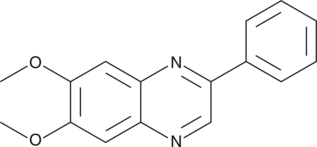Chemicals
Showing 8401–8550 of 41137 results
-
Adiponectin expressed by adipocytes exerts antidiabetic effects by binding to adiponectin receptor (AdipoR)1, which activates AMPK pathways, and AdipoR2, which activates PPARα pathways. AdipoRon is an orally active small molecule AdipoR agonist that binds AdipoR1 and AdipoR2 with KD values of 1.8 and 3.1 µM, respectively.{25721} At 50 mg/kg, it acts similarly to adiponectin, activating AMPK and PPARα pathways and reducing insulin resistance and glucose intolerance in wild type mice fed a high-fat diet and in genetically obese db/db mice.{25721}
Brand:CaymanSKU:- -
Adiponectin expressed by adipocytes exerts antidiabetic effects by binding to adiponectin receptor (AdipoR)1, which activates AMPK pathways, and AdipoR2, which activates PPARα pathways. AdipoRon is an orally active small molecule AdipoR agonist that binds AdipoR1 and AdipoR2 with KD values of 1.8 and 3.1 µM, respectively.{25721} At 50 mg/kg, it acts similarly to adiponectin, activating AMPK and PPARα pathways and reducing insulin resistance and glucose intolerance in wild type mice fed a high-fat diet and in genetically obese db/db mice.{25721}
Brand:CaymanSKU:- -
Adiponectin expressed by adipocytes exerts antidiabetic effects by binding to adiponectin receptor (AdipoR)1, which activates AMPK pathways, and AdipoR2, which activates PPARα pathways. AdipoRon is an orally active small molecule AdipoR agonist that binds AdipoR1 and AdipoR2 with KD values of 1.8 and 3.1 µM, respectively.{25721} At 50 mg/kg, it acts similarly to adiponectin, activating AMPK and PPARα pathways and reducing insulin resistance and glucose intolerance in wild type mice fed a high-fat diet and in genetically obese db/db mice.{25721}
Brand:CaymanSKU:- -
Adipostatin A is an inhibitor of glycerol-3-phosphate dehydrogenase (GPDH; IC50 = 4.1 µM).{34617} It prevents triglyceride accumulation in 3T3-L1 cells when applied at 5-7.5 µM.{34617} Adipostatin A is cytotoxic against fibroblast carcinoma KB cell lines with an IC50 value of 10.6 µM.{34618} It also shows larvicidal activity (LC90 = 10.22 ppm) against A. aegypti.{34619}
Brand:CaymanSKU:22163 -Out of stock
-
Adipostatin A is an inhibitor of glycerol-3-phosphate dehydrogenase (GPDH; IC50 = 4.1 µM).{34617} It prevents triglyceride accumulation in 3T3-L1 cells when applied at 5-7.5 µM.{34617} Adipostatin A is cytotoxic against fibroblast carcinoma KB cell lines with an IC50 value of 10.6 µM.{34618} It also shows larvicidal activity (LC90 = 10.22 ppm) against A. aegypti.{34619}
Brand:CaymanSKU:22163 -Out of stock
-
Adjudin is a derivative of ionidamine that inhibits human spermatozoa capacitance, potentially by blocking chloride channels.{40350} It inhibits spermatozoa hyperactivated motility and the acrosome reaction and prevents sperm-egg fusion in zona-free hamster eggs. It also disrupts Sertoli-germ cell junctions by increasing tight junction and basal ectoplasmic specialization protein levels, which tightens the cell permeability barrier dose-dependently in vitro.{40351} Adjudin (25 and 50 mg/kg) increases testin expression in adult rat testes within one day and depletes spermatids and spermatocytes within 14 days.{40349} Under various dosing parameters, adjudin reversibly induces infertility of male rats within 3-7 weeks, which lasts 4-14 weeks, without affecting serum levels of luteinizing hormone (LH), follicle stimulating hormone (FSH), or testosterone. Adjudin also decreases proliferation of SGC-7901, MDA-MB-231, Smmc-7721, and MIA Paca-2 cells (IC50s = 58, 13.8, 72.3, and 52.7 µM, respectively) and induces apoptosis via the caspase-3-dependent pathway.{40352}
Brand:CaymanSKU:22939 - 1 mgAvailable on backorder
-
Adjudin is a derivative of ionidamine that inhibits human spermatozoa capacitance, potentially by blocking chloride channels.{40350} It inhibits spermatozoa hyperactivated motility and the acrosome reaction and prevents sperm-egg fusion in zona-free hamster eggs. It also disrupts Sertoli-germ cell junctions by increasing tight junction and basal ectoplasmic specialization protein levels, which tightens the cell permeability barrier dose-dependently in vitro.{40351} Adjudin (25 and 50 mg/kg) increases testin expression in adult rat testes within one day and depletes spermatids and spermatocytes within 14 days.{40349} Under various dosing parameters, adjudin reversibly induces infertility of male rats within 3-7 weeks, which lasts 4-14 weeks, without affecting serum levels of luteinizing hormone (LH), follicle stimulating hormone (FSH), or testosterone. Adjudin also decreases proliferation of SGC-7901, MDA-MB-231, Smmc-7721, and MIA Paca-2 cells (IC50s = 58, 13.8, 72.3, and 52.7 µM, respectively) and induces apoptosis via the caspase-3-dependent pathway.{40352}
Brand:CaymanSKU:22939 - 10 mgAvailable on backorder
-
Adjudin is a derivative of ionidamine that inhibits human spermatozoa capacitance, potentially by blocking chloride channels.{40350} It inhibits spermatozoa hyperactivated motility and the acrosome reaction and prevents sperm-egg fusion in zona-free hamster eggs. It also disrupts Sertoli-germ cell junctions by increasing tight junction and basal ectoplasmic specialization protein levels, which tightens the cell permeability barrier dose-dependently in vitro.{40351} Adjudin (25 and 50 mg/kg) increases testin expression in adult rat testes within one day and depletes spermatids and spermatocytes within 14 days.{40349} Under various dosing parameters, adjudin reversibly induces infertility of male rats within 3-7 weeks, which lasts 4-14 weeks, without affecting serum levels of luteinizing hormone (LH), follicle stimulating hormone (FSH), or testosterone. Adjudin also decreases proliferation of SGC-7901, MDA-MB-231, Smmc-7721, and MIA Paca-2 cells (IC50s = 58, 13.8, 72.3, and 52.7 µM, respectively) and induces apoptosis via the caspase-3-dependent pathway.{40352}
Brand:CaymanSKU:22939 - 25 mgAvailable on backorder
-
Adjudin is a derivative of ionidamine that inhibits human spermatozoa capacitance, potentially by blocking chloride channels.{40350} It inhibits spermatozoa hyperactivated motility and the acrosome reaction and prevents sperm-egg fusion in zona-free hamster eggs. It also disrupts Sertoli-germ cell junctions by increasing tight junction and basal ectoplasmic specialization protein levels, which tightens the cell permeability barrier dose-dependently in vitro.{40351} Adjudin (25 and 50 mg/kg) increases testin expression in adult rat testes within one day and depletes spermatids and spermatocytes within 14 days.{40349} Under various dosing parameters, adjudin reversibly induces infertility of male rats within 3-7 weeks, which lasts 4-14 weeks, without affecting serum levels of luteinizing hormone (LH), follicle stimulating hormone (FSH), or testosterone. Adjudin also decreases proliferation of SGC-7901, MDA-MB-231, Smmc-7721, and MIA Paca-2 cells (IC50s = 58, 13.8, 72.3, and 52.7 µM, respectively) and induces apoptosis via the caspase-3-dependent pathway.{40352}
Brand:CaymanSKU:22939 - 5 mgAvailable on backorder
-
ADL5859 is a δ-opioid receptor agonist (Ki = 0.84 nM).{45386} It is selective for δ-opioid receptors over μ-opioid and κ-opioid receptors exhibiting 32 and 37% inhibition, respectively, in radioligand binding assays when used at a concentration of 10 μM. ADL5859 (3 mg/kg) completely reverses mechanical hyperalgesia induced by complete Freund’s adjuvant (CFA) in rats. It also decreases immobility time in the forced swim test in rats, indicating antidepressant-like activity.
Brand:CaymanSKU:27796 - 10 mgAvailable on backorder
-
ADL5859 is a δ-opioid receptor agonist (Ki = 0.84 nM).{45386} It is selective for δ-opioid receptors over μ-opioid and κ-opioid receptors exhibiting 32 and 37% inhibition, respectively, in radioligand binding assays when used at a concentration of 10 μM. ADL5859 (3 mg/kg) completely reverses mechanical hyperalgesia induced by complete Freund’s adjuvant (CFA) in rats. It also decreases immobility time in the forced swim test in rats, indicating antidepressant-like activity.
Brand:CaymanSKU:27796 - 25 mgAvailable on backorder
-
ADL5859 is a δ-opioid receptor agonist (Ki = 0.84 nM).{45386} It is selective for δ-opioid receptors over μ-opioid and κ-opioid receptors exhibiting 32 and 37% inhibition, respectively, in radioligand binding assays when used at a concentration of 10 μM. ADL5859 (3 mg/kg) completely reverses mechanical hyperalgesia induced by complete Freund’s adjuvant (CFA) in rats. It also decreases immobility time in the forced swim test in rats, indicating antidepressant-like activity.
Brand:CaymanSKU:27796 - 5 mgAvailable on backorder
-
ADL5859 is a δ-opioid receptor agonist (Ki = 0.84 nM).{45386} It is selective for δ-opioid receptors over μ-opioid and κ-opioid receptors exhibiting 32 and 37% inhibition, respectively, in radioligand binding assays when used at a concentration of 10 μM. ADL5859 (3 mg/kg) completely reverses mechanical hyperalgesia induced by complete Freund’s adjuvant (CFA) in rats. It also decreases immobility time in the forced swim test in rats, indicating antidepressant-like activity.
Brand:CaymanSKU:27796 - 50 mgAvailable on backorder
-
Adomeglivant is an allosteric antagonist of the glucagon receptor.{47796,47797} It inhibits glucagon-induced increases in cAMP levels in HEK293 cells expressing the rat glucagon or GLP-1 receptors (IC50s = 1.8 and 1.2 µM, respectively) but has no effect on cAMP levels when used alone.{47797} Adomeglivant also inhibits increases in cAMP levels induced by GLP-1 or exendin-4 (Item No. 11096) in HEK293 cells expressing the GLP-1 receptor (IC50s = 7 and 12 µM, respectively). It decreases glucose-stimulated insulin secretion when used at a concentration of 1 µM in combination with the GLP-1 receptor antagonist exendin (9-39) in isolated human islets but not glucose-stimulated glucagon secretion when used alone or in combination with exendin (9-39) in isolated mouse islets.{47798}
Brand:CaymanSKU:29668 - 1 mgAvailable on backorder
-
Adomeglivant is an allosteric antagonist of the glucagon receptor.{47796,47797} It inhibits glucagon-induced increases in cAMP levels in HEK293 cells expressing the rat glucagon or GLP-1 receptors (IC50s = 1.8 and 1.2 µM, respectively) but has no effect on cAMP levels when used alone.{47797} Adomeglivant also inhibits increases in cAMP levels induced by GLP-1 or exendin-4 (Item No. 11096) in HEK293 cells expressing the GLP-1 receptor (IC50s = 7 and 12 µM, respectively). It decreases glucose-stimulated insulin secretion when used at a concentration of 1 µM in combination with the GLP-1 receptor antagonist exendin (9-39) in isolated human islets but not glucose-stimulated glucagon secretion when used alone or in combination with exendin (9-39) in isolated mouse islets.{47798}
Brand:CaymanSKU:29668 - 10 mgAvailable on backorder
-
Adomeglivant is an allosteric antagonist of the glucagon receptor.{47796,47797} It inhibits glucagon-induced increases in cAMP levels in HEK293 cells expressing the rat glucagon or GLP-1 receptors (IC50s = 1.8 and 1.2 µM, respectively) but has no effect on cAMP levels when used alone.{47797} Adomeglivant also inhibits increases in cAMP levels induced by GLP-1 or exendin-4 (Item No. 11096) in HEK293 cells expressing the GLP-1 receptor (IC50s = 7 and 12 µM, respectively). It decreases glucose-stimulated insulin secretion when used at a concentration of 1 µM in combination with the GLP-1 receptor antagonist exendin (9-39) in isolated human islets but not glucose-stimulated glucagon secretion when used alone or in combination with exendin (9-39) in isolated mouse islets.{47798}
Brand:CaymanSKU:29668 - 25 mgAvailable on backorder
-
Adomeglivant is an allosteric antagonist of the glucagon receptor.{47796,47797} It inhibits glucagon-induced increases in cAMP levels in HEK293 cells expressing the rat glucagon or GLP-1 receptors (IC50s = 1.8 and 1.2 µM, respectively) but has no effect on cAMP levels when used alone.{47797} Adomeglivant also inhibits increases in cAMP levels induced by GLP-1 or exendin-4 (Item No. 11096) in HEK293 cells expressing the GLP-1 receptor (IC50s = 7 and 12 µM, respectively). It decreases glucose-stimulated insulin secretion when used at a concentration of 1 µM in combination with the GLP-1 receptor antagonist exendin (9-39) in isolated human islets but not glucose-stimulated glucagon secretion when used alone or in combination with exendin (9-39) in isolated mouse islets.{47798}
Brand:CaymanSKU:29668 - 5 mgAvailable on backorder
-
ADP-Glucose (ADPG) is an immediate precursor used in the biosynthesis, by glucose addition, of storage polysaccharides in plants, green algae, and cyanobacteria, as well as structural polysaccharides in certain bacteria.{29649,29651} It is used by amylose synthases or starch synthases in plastids in the production of amylose, amylopectins, starch, and other polysaccharides. ADPG is normally generated within plastids, although it can be biosynthesized in the cytoplasm of certain grasses and imported into plastids by a membrane-bound transporter.{29650}
Brand:CaymanSKU:-Available on backorder
-
ADP-Glucose (ADPG) is an immediate precursor used in the biosynthesis, by glucose addition, of storage polysaccharides in plants, green algae, and cyanobacteria, as well as structural polysaccharides in certain bacteria.{29649,29651} It is used by amylose synthases or starch synthases in plastids in the production of amylose, amylopectins, starch, and other polysaccharides. ADPG is normally generated within plastids, although it can be biosynthesized in the cytoplasm of certain grasses and imported into plastids by a membrane-bound transporter.{29650}
Brand:CaymanSKU:-Available on backorder
-
ADP-Glucose (ADPG) is an immediate precursor used in the biosynthesis, by glucose addition, of storage polysaccharides in plants, green algae, and cyanobacteria, as well as structural polysaccharides in certain bacteria.{29649,29651} It is used by amylose synthases or starch synthases in plastids in the production of amylose, amylopectins, starch, and other polysaccharides. ADPG is normally generated within plastids, although it can be biosynthesized in the cytoplasm of certain grasses and imported into plastids by a membrane-bound transporter.{29650}
Brand:CaymanSKU:-Available on backorder
-
Adrafinil (Item No. 19773) is an analytical reference standard categorized as a nootropic.{49003} It is a prodrug form of the nootropic stimulant modafinil (Item No. 15417). This product is intended for research and forensic applications.
Brand:CaymanSKU:19773 -Available on backorder
-
Adrafinil (Item No. 19773) is an analytical reference standard categorized as a nootropic.{49003} It is a prodrug form of the nootropic stimulant modafinil (Item No. 15417). This product is intended for research and forensic applications.
Brand:CaymanSKU:19773 -Available on backorder
-
ADT-OH is a derivative of anethole dithiolethione (ADT) and synthetic hydrogen sulfide (H2S) donor. It can be readily esterified with other moieties.{28631} For example, it can be coupled with therapeutics like nonsteroidal anti-inflammatory drugs, as in the generation of ATB-343 (Item No. 13045).{15971} ADT-OH has also been linked with a mitochondria-targeting motif to produce AP-39 (Item No. 17100), which selectively increases mitochondrial H2S levels.{28632} ADT-OH is used both in cells and in animals for comparative studies with derived chimeras.{28632,28633}
Brand:CaymanSKU:-Out of stock
-
ADT-OH is a derivative of anethole dithiolethione (ADT) and synthetic hydrogen sulfide (H2S) donor. It can be readily esterified with other moieties.{28631} For example, it can be coupled with therapeutics like nonsteroidal anti-inflammatory drugs, as in the generation of ATB-343 (Item No. 13045).{15971} ADT-OH has also been linked with a mitochondria-targeting motif to produce AP-39 (Item No. 17100), which selectively increases mitochondrial H2S levels.{28632} ADT-OH is used both in cells and in animals for comparative studies with derived chimeras.{28632,28633}
Brand:CaymanSKU:-Out of stock
-
ADT-OH is a derivative of anethole dithiolethione (ADT) and synthetic hydrogen sulfide (H2S) donor. It can be readily esterified with other moieties.{28631} For example, it can be coupled with therapeutics like nonsteroidal anti-inflammatory drugs, as in the generation of ATB-343 (Item No. 13045).{15971} ADT-OH has also been linked with a mitochondria-targeting motif to produce AP-39 (Item No. 17100), which selectively increases mitochondrial H2S levels.{28632} ADT-OH is used both in cells and in animals for comparative studies with derived chimeras.{28632,28633}
Brand:CaymanSKU:-Out of stock
-
ADT-OH is a derivative of anethole dithiolethione (ADT) and synthetic hydrogen sulfide (H2S) donor. It can be readily esterified with other moieties.{28631} For example, it can be coupled with therapeutics like nonsteroidal anti-inflammatory drugs, as in the generation of ATB-343 (Item No. 13045).{15971} ADT-OH has also been linked with a mitochondria-targeting motif to produce AP-39 (Item No. 17100), which selectively increases mitochondrial H2S levels.{28632} ADT-OH is used both in cells and in animals for comparative studies with derived chimeras.{28632,28633}
Brand:CaymanSKU:-Out of stock
-
ADTL-EI1712 is a dual inhibitor of ERK1 and ERK5 (IC50s = 40.43 and 64.5 nM, respectively).{59056} It reduces ERK1 and ERK5 activity by 93.5% and 89.4%, respectively, but also inhibits ERK2 activity by 92.7%, in a panel of 100 kinases at 1 µM. ADTL-EI1712 inhibits proliferation of HL-60 and MKN74, but not HeLa, cancer cells (IC50s = 1.26, 2.55, and >50 µM, respectively). It reduces tumor growth and intratumor phosphorylation of ERK1/2 and ERK5 in an MKN74 mouse xenograft model when administered at a dose of 50 mg/kg per day.
Brand:CaymanSKU:30602 - 1 mgAvailable on backorder
-
ADTL-EI1712 is a dual inhibitor of ERK1 and ERK5 (IC50s = 40.43 and 64.5 nM, respectively).{59056} It reduces ERK1 and ERK5 activity by 93.5% and 89.4%, respectively, but also inhibits ERK2 activity by 92.7%, in a panel of 100 kinases at 1 µM. ADTL-EI1712 inhibits proliferation of HL-60 and MKN74, but not HeLa, cancer cells (IC50s = 1.26, 2.55, and >50 µM, respectively). It reduces tumor growth and intratumor phosphorylation of ERK1/2 and ERK5 in an MKN74 mouse xenograft model when administered at a dose of 50 mg/kg per day.
Brand:CaymanSKU:30602 - 10 mgAvailable on backorder
-
ADTL-EI1712 is a dual inhibitor of ERK1 and ERK5 (IC50s = 40.43 and 64.5 nM, respectively).{59056} It reduces ERK1 and ERK5 activity by 93.5% and 89.4%, respectively, but also inhibits ERK2 activity by 92.7%, in a panel of 100 kinases at 1 µM. ADTL-EI1712 inhibits proliferation of HL-60 and MKN74, but not HeLa, cancer cells (IC50s = 1.26, 2.55, and >50 µM, respectively). It reduces tumor growth and intratumor phosphorylation of ERK1/2 and ERK5 in an MKN74 mouse xenograft model when administered at a dose of 50 mg/kg per day.
Brand:CaymanSKU:30602 - 25 mgAvailable on backorder
-
ADTL-EI1712 is a dual inhibitor of ERK1 and ERK5 (IC50s = 40.43 and 64.5 nM, respectively).{59056} It reduces ERK1 and ERK5 activity by 93.5% and 89.4%, respectively, but also inhibits ERK2 activity by 92.7%, in a panel of 100 kinases at 1 µM. ADTL-EI1712 inhibits proliferation of HL-60 and MKN74, but not HeLa, cancer cells (IC50s = 1.26, 2.55, and >50 µM, respectively). It reduces tumor growth and intratumor phosphorylation of ERK1/2 and ERK5 in an MKN74 mouse xenograft model when administered at a dose of 50 mg/kg per day.
Brand:CaymanSKU:30602 - 5 mgAvailable on backorder
-
ADX-47273 is a positive allosteric modulator of metabotropic glutamate receptor 5 (mGluR5) with EC50 values of 0.17 and 0.23 μM for potentiation of glutamate activity in HEK293 cells expressing rat mGluR5 and primary astrocyte cultures, respectively.{37446} It is selective for mGluR5 over rat mGluR1 and human mGluR1 and mGluR4 when used at concentrations up to 10 μM. In vivo, ADX-47273 (1 and 10 mg/kg, i.p.) increases ERK and CREB phosphorylation in the hippocampus and prefrontal cortex in rats. It decreases the conditioned avoidance response, apomorphine-induced climbing, as well as PCP-, apomorphine-, and amphetamine-induced locomotor activity in rats in a dose-dependent manner, indicating antipsychotic-like activity. ADX-47273 (0.1-50 mg/kg, i.p) improves recall in a novel object recognition test and reduces impulsivity in the 5-choice serial reaction time task (5CSRTT). It also enhances reversal learning in mice in the Morris water maze test.{37447}
Brand:CaymanSKU:-Available on backorder
-
ADX-47273 is a positive allosteric modulator of metabotropic glutamate receptor 5 (mGluR5) with EC50 values of 0.17 and 0.23 μM for potentiation of glutamate activity in HEK293 cells expressing rat mGluR5 and primary astrocyte cultures, respectively.{37446} It is selective for mGluR5 over rat mGluR1 and human mGluR1 and mGluR4 when used at concentrations up to 10 μM. In vivo, ADX-47273 (1 and 10 mg/kg, i.p.) increases ERK and CREB phosphorylation in the hippocampus and prefrontal cortex in rats. It decreases the conditioned avoidance response, apomorphine-induced climbing, as well as PCP-, apomorphine-, and amphetamine-induced locomotor activity in rats in a dose-dependent manner, indicating antipsychotic-like activity. ADX-47273 (0.1-50 mg/kg, i.p) improves recall in a novel object recognition test and reduces impulsivity in the 5-choice serial reaction time task (5CSRTT). It also enhances reversal learning in mice in the Morris water maze test.{37447}
Brand:CaymanSKU:-Available on backorder
-
ADX-47273 is a positive allosteric modulator of metabotropic glutamate receptor 5 (mGluR5) with EC50 values of 0.17 and 0.23 μM for potentiation of glutamate activity in HEK293 cells expressing rat mGluR5 and primary astrocyte cultures, respectively.{37446} It is selective for mGluR5 over rat mGluR1 and human mGluR1 and mGluR4 when used at concentrations up to 10 μM. In vivo, ADX-47273 (1 and 10 mg/kg, i.p.) increases ERK and CREB phosphorylation in the hippocampus and prefrontal cortex in rats. It decreases the conditioned avoidance response, apomorphine-induced climbing, as well as PCP-, apomorphine-, and amphetamine-induced locomotor activity in rats in a dose-dependent manner, indicating antipsychotic-like activity. ADX-47273 (0.1-50 mg/kg, i.p) improves recall in a novel object recognition test and reduces impulsivity in the 5-choice serial reaction time task (5CSRTT). It also enhances reversal learning in mice in the Morris water maze test.{37447}
Brand:CaymanSKU:-Available on backorder
-
ADX-47273 is a positive allosteric modulator of metabotropic glutamate receptor 5 (mGluR5) with EC50 values of 0.17 and 0.23 μM for potentiation of glutamate activity in HEK293 cells expressing rat mGluR5 and primary astrocyte cultures, respectively.{37446} It is selective for mGluR5 over rat mGluR1 and human mGluR1 and mGluR4 when used at concentrations up to 10 μM. In vivo, ADX-47273 (1 and 10 mg/kg, i.p.) increases ERK and CREB phosphorylation in the hippocampus and prefrontal cortex in rats. It decreases the conditioned avoidance response, apomorphine-induced climbing, as well as PCP-, apomorphine-, and amphetamine-induced locomotor activity in rats in a dose-dependent manner, indicating antipsychotic-like activity. ADX-47273 (0.1-50 mg/kg, i.p) improves recall in a novel object recognition test and reduces impulsivity in the 5-choice serial reaction time task (5CSRTT). It also enhances reversal learning in mice in the Morris water maze test.{37447}
Brand:CaymanSKU:-Available on backorder
-
AEBSF is a water soluble, irreversible, broad spectrum inhibitor of serine proteases, including trypsin, chymotrypsin, plasmin, thrombin, and kallikreins.{22765} AEBSF can also prevent the activation of the ROS generator, NADPH oxidase.{22764} At 10-50 μg, AEBSF can attenuate airway inflammation in a mouse model of airway allergy.{22763} AEBSF maintains stability in slightly acidic aqueous solutions and serves as a nontoxic alternative to the organophosphate inhibitors, PMSF and DFP.{22765}
Brand:CaymanSKU:- -
AEBSF is a water soluble, irreversible, broad spectrum inhibitor of serine proteases, including trypsin, chymotrypsin, plasmin, thrombin, and kallikreins.{22765} AEBSF can also prevent the activation of the ROS generator, NADPH oxidase.{22764} At 10-50 μg, AEBSF can attenuate airway inflammation in a mouse model of airway allergy.{22763} AEBSF maintains stability in slightly acidic aqueous solutions and serves as a nontoxic alternative to the organophosphate inhibitors, PMSF and DFP.{22765}
Brand:CaymanSKU:- -
AEBSF is a water soluble, irreversible, broad spectrum inhibitor of serine proteases, including trypsin, chymotrypsin, plasmin, thrombin, and kallikreins.{22765} AEBSF can also prevent the activation of the ROS generator, NADPH oxidase.{22764} At 10-50 μg, AEBSF can attenuate airway inflammation in a mouse model of airway allergy.{22763} AEBSF maintains stability in slightly acidic aqueous solutions and serves as a nontoxic alternative to the organophosphate inhibitors, PMSF and DFP.{22765}
Brand:CaymanSKU:- -
AEE788 is an inhibitor of both epidermal growth factor (EGF) and vascular endothelial growth factor (VEGF) receptor tyrosine kinase family members.{31022} It can inhibit EGFR and VEGFR tyrosine kinases with IC50 values of 2, 6, 77, and 59 nM for EGFR, ErbB2, KDR, and FLT1, respectively.{31022} AEE788 demonstrates antiproliferative activity against a range of EGFR and ErbB2-overexpressing cell lines and can inhibit the proliferation of EGF- and VEGF-stimulated human umbilical vein endothelial cells.{31022} It also has been shown to have antitumor and anti-angiogenic activity in numerous animal models of cancer.{31022}
Brand:CaymanSKU:-Available on backorder
-
AEE788 is an inhibitor of both epidermal growth factor (EGF) and vascular endothelial growth factor (VEGF) receptor tyrosine kinase family members.{31022} It can inhibit EGFR and VEGFR tyrosine kinases with IC50 values of 2, 6, 77, and 59 nM for EGFR, ErbB2, KDR, and FLT1, respectively.{31022} AEE788 demonstrates antiproliferative activity against a range of EGFR and ErbB2-overexpressing cell lines and can inhibit the proliferation of EGF- and VEGF-stimulated human umbilical vein endothelial cells.{31022} It also has been shown to have antitumor and anti-angiogenic activity in numerous animal models of cancer.{31022}
Brand:CaymanSKU:-Available on backorder
-
AEE788 is an inhibitor of both epidermal growth factor (EGF) and vascular endothelial growth factor (VEGF) receptor tyrosine kinase family members.{31022} It can inhibit EGFR and VEGFR tyrosine kinases with IC50 values of 2, 6, 77, and 59 nM for EGFR, ErbB2, KDR, and FLT1, respectively.{31022} AEE788 demonstrates antiproliferative activity against a range of EGFR and ErbB2-overexpressing cell lines and can inhibit the proliferation of EGF- and VEGF-stimulated human umbilical vein endothelial cells.{31022} It also has been shown to have antitumor and anti-angiogenic activity in numerous animal models of cancer.{31022}
Brand:CaymanSKU:-Available on backorder
-
AEE788 is an inhibitor of both epidermal growth factor (EGF) and vascular endothelial growth factor (VEGF) receptor tyrosine kinase family members.{31022} It can inhibit EGFR and VEGFR tyrosine kinases with IC50 values of 2, 6, 77, and 59 nM for EGFR, ErbB2, KDR, and FLT1, respectively.{31022} AEE788 demonstrates antiproliferative activity against a range of EGFR and ErbB2-overexpressing cell lines and can inhibit the proliferation of EGF- and VEGF-stimulated human umbilical vein endothelial cells.{31022} It also has been shown to have antitumor and anti-angiogenic activity in numerous animal models of cancer.{31022}
Brand:CaymanSKU:-Available on backorder
-
AEG 3482 is an inhibitor of p75NTR- and NRAGE-induced apoptosis.{49017} It inhibits JNK signaling, caspase-3 cleavage, and cell death induced by the p75 neurotrophin receptor (p75NTR) or the p75NTR-interacting protein NRAGE in PC12rtTA cells in a concentration-dependent manner. AEG 3482 inhibits cell death induced by withdrawal of nerve growth factor (NGF) in rat SCG neurons (EC50 = ~20 μM). It also increases Hsp70 and Hsp25 levels in mouse embryonic fibroblasts (MEFs) in an HSF1-dependent manner and binds to recombinant Hsp90.
Brand:CaymanSKU:26213 - 1 mgAvailable on backorder
-
AEG 3482 is an inhibitor of p75NTR- and NRAGE-induced apoptosis.{49017} It inhibits JNK signaling, caspase-3 cleavage, and cell death induced by the p75 neurotrophin receptor (p75NTR) or the p75NTR-interacting protein NRAGE in PC12rtTA cells in a concentration-dependent manner. AEG 3482 inhibits cell death induced by withdrawal of nerve growth factor (NGF) in rat SCG neurons (EC50 = ~20 μM). It also increases Hsp70 and Hsp25 levels in mouse embryonic fibroblasts (MEFs) in an HSF1-dependent manner and binds to recombinant Hsp90.
Brand:CaymanSKU:26213 - 10 mgAvailable on backorder
-
AEG 3482 is an inhibitor of p75NTR- and NRAGE-induced apoptosis.{49017} It inhibits JNK signaling, caspase-3 cleavage, and cell death induced by the p75 neurotrophin receptor (p75NTR) or the p75NTR-interacting protein NRAGE in PC12rtTA cells in a concentration-dependent manner. AEG 3482 inhibits cell death induced by withdrawal of nerve growth factor (NGF) in rat SCG neurons (EC50 = ~20 μM). It also increases Hsp70 and Hsp25 levels in mouse embryonic fibroblasts (MEFs) in an HSF1-dependent manner and binds to recombinant Hsp90.
Brand:CaymanSKU:26213 - 25 mgAvailable on backorder
-
AEG 3482 is an inhibitor of p75NTR- and NRAGE-induced apoptosis.{49017} It inhibits JNK signaling, caspase-3 cleavage, and cell death induced by the p75 neurotrophin receptor (p75NTR) or the p75NTR-interacting protein NRAGE in PC12rtTA cells in a concentration-dependent manner. AEG 3482 inhibits cell death induced by withdrawal of nerve growth factor (NGF) in rat SCG neurons (EC50 = ~20 μM). It also increases Hsp70 and Hsp25 levels in mouse embryonic fibroblasts (MEFs) in an HSF1-dependent manner and binds to recombinant Hsp90.
Brand:CaymanSKU:26213 - 5 mgAvailable on backorder
-
Cancer cell survival appears partly dependent on antioxidative enzymes, whose expression is regulated by the Keap1-Nrf2 pathway, to quench potentially toxic reactive oxygen species generated by their metastatic transformation.{20112} AEM1 is an inhibitor of gene expression induced by nuclear erythroid 2-related factor 2 (Nrf2).{29333} It reduces Nrf2-dependent expression of the genes encoding superoxide dismutase 1 (SOD1), heme oxygenase 1 (HO-1), thioredoxin (Trx), glutamate-cysteine ligase (GCLM), and glutathione peroxidase 2 (GPX2), as well as decreases glutathione (GSH) content in A549 cells when used at 5 µM. AEM1 enhances tert-butyl hydroperoxide-induced A549 cell death. In vivo, AEM1 (50 mg/kg) reduces tumor volume in an A549 mouse xenograft model.
Brand:CaymanSKU:-Available on backorder
-
Cancer cell survival appears partly dependent on antioxidative enzymes, whose expression is regulated by the Keap1-Nrf2 pathway, to quench potentially toxic reactive oxygen species generated by their metastatic transformation.{20112} AEM1 is an inhibitor of gene expression induced by nuclear erythroid 2-related factor 2 (Nrf2).{29333} It reduces Nrf2-dependent expression of the genes encoding superoxide dismutase 1 (SOD1), heme oxygenase 1 (HO-1), thioredoxin (Trx), glutamate-cysteine ligase (GCLM), and glutathione peroxidase 2 (GPX2), as well as decreases glutathione (GSH) content in A549 cells when used at 5 µM. AEM1 enhances tert-butyl hydroperoxide-induced A549 cell death. In vivo, AEM1 (50 mg/kg) reduces tumor volume in an A549 mouse xenograft model.
Brand:CaymanSKU:-Available on backorder
-
Cancer cell survival appears partly dependent on antioxidative enzymes, whose expression is regulated by the Keap1-Nrf2 pathway, to quench potentially toxic reactive oxygen species generated by their metastatic transformation.{20112} AEM1 is an inhibitor of gene expression induced by nuclear erythroid 2-related factor 2 (Nrf2).{29333} It reduces Nrf2-dependent expression of the genes encoding superoxide dismutase 1 (SOD1), heme oxygenase 1 (HO-1), thioredoxin (Trx), glutamate-cysteine ligase (GCLM), and glutathione peroxidase 2 (GPX2), as well as decreases glutathione (GSH) content in A549 cells when used at 5 µM. AEM1 enhances tert-butyl hydroperoxide-induced A549 cell death. In vivo, AEM1 (50 mg/kg) reduces tumor volume in an A549 mouse xenograft model.
Brand:CaymanSKU:-Available on backorder
-
Aerothionin is a dimeric spiroisoxazoline derived from marine sponges that demonstrates antimycobacterial activity.{29660} It is cytotoxic to HeLa cells, inhibiting proliferation with an IC50 value of 29 µM.{29660}
Brand:CaymanSKU:-Available on backorder
-
AF-353 is a noncompetitive dual antagonist of the purinoreceptors P2X3 and P2X2/3 (IC50s = 10 and 79.4 nM, respectively).{47203,47204} It is selective for P2X3 and P2X2/3 over P2X1, P2X2, P2X4, P2X5, and P2X7 (IC50 = >10 µM for all).{47204} It inhibits calcium flux in CHO-K1 cells expressing the rat P2X3 receptor and in 1321N1 cells expressing the human P2X3 and P2X2/3 receptors (IC50s = 8.91, 8.71, and 38.9 nM, respectively). AF-353 decreases the electrical signals in the detrusor, but not striated, muscle of the bladder in female rats.{47205}
Brand:CaymanSKU:23034 - 1 mgAvailable on backorder
-
AF-353 is a noncompetitive dual antagonist of the purinoreceptors P2X3 and P2X2/3 (IC50s = 10 and 79.4 nM, respectively).{47203,47204} It is selective for P2X3 and P2X2/3 over P2X1, P2X2, P2X4, P2X5, and P2X7 (IC50 = >10 µM for all).{47204} It inhibits calcium flux in CHO-K1 cells expressing the rat P2X3 receptor and in 1321N1 cells expressing the human P2X3 and P2X2/3 receptors (IC50s = 8.91, 8.71, and 38.9 nM, respectively). AF-353 decreases the electrical signals in the detrusor, but not striated, muscle of the bladder in female rats.{47205}
Brand:CaymanSKU:23034 - 10 mgAvailable on backorder
-
AF-353 is a noncompetitive dual antagonist of the purinoreceptors P2X3 and P2X2/3 (IC50s = 10 and 79.4 nM, respectively).{47203,47204} It is selective for P2X3 and P2X2/3 over P2X1, P2X2, P2X4, P2X5, and P2X7 (IC50 = >10 µM for all).{47204} It inhibits calcium flux in CHO-K1 cells expressing the rat P2X3 receptor and in 1321N1 cells expressing the human P2X3 and P2X2/3 receptors (IC50s = 8.91, 8.71, and 38.9 nM, respectively). AF-353 decreases the electrical signals in the detrusor, but not striated, muscle of the bladder in female rats.{47205}
Brand:CaymanSKU:23034 - 5 mgAvailable on backorder
-
AF-DX 116 is an antagonist of M2 muscarinic acetylcholine receptors (Ki = 0.2 µM).{52673} It is selective for cardiac M2 over salivary gland M3 receptors (Ki = 5.01 µM) but also binds sympathetic ganglia M1 receptors (Ki = 0.81 µM). AF-DX 116 (0.1 µM) increases vagus nerve stimulation-induced increases in perfusion pressure by 50% in isolated perfused rat hearts.{52674} It increases systolic blood pressure and heart rate in a rat model of hypotension induced by repeated cold stress when administered intravenously at doses of 50, 100, and 200 µg/kg.{52675}
Brand:CaymanSKU:30871 - 1 mgAvailable on backorder
-
AF-DX 116 is an antagonist of M2 muscarinic acetylcholine receptors (Ki = 0.2 µM).{52673} It is selective for cardiac M2 over salivary gland M3 receptors (Ki = 5.01 µM) but also binds sympathetic ganglia M1 receptors (Ki = 0.81 µM). AF-DX 116 (0.1 µM) increases vagus nerve stimulation-induced increases in perfusion pressure by 50% in isolated perfused rat hearts.{52674} It increases systolic blood pressure and heart rate in a rat model of hypotension induced by repeated cold stress when administered intravenously at doses of 50, 100, and 200 µg/kg.{52675}
Brand:CaymanSKU:30871 - 10 mgAvailable on backorder
-
AF-DX 116 is an antagonist of M2 muscarinic acetylcholine receptors (Ki = 0.2 µM).{52673} It is selective for cardiac M2 over salivary gland M3 receptors (Ki = 5.01 µM) but also binds sympathetic ganglia M1 receptors (Ki = 0.81 µM). AF-DX 116 (0.1 µM) increases vagus nerve stimulation-induced increases in perfusion pressure by 50% in isolated perfused rat hearts.{52674} It increases systolic blood pressure and heart rate in a rat model of hypotension induced by repeated cold stress when administered intravenously at doses of 50, 100, and 200 µg/kg.{52675}
Brand:CaymanSKU:30871 - 5 mgAvailable on backorder
-
AF-DX 384 is an antagonist of M2 and M4 muscarinic acetylcholine receptors (Kis = 6.03 and 10 nM, respectively).{42379} It is selective for M2 and M4 over M1, M3, and M5 receptors (Kis = 30.9, 66.07, and 537.03 nM, respectively). AF-DX 384 increases acetylcholine release in the hippocampus and cortex of young and aged rats in vivo when infused locally at a concentration of 1 µM and in the cortex when administered intraperitoneally at a dose of 5 mg/kg.{42380} It reverses deficits in novel object recognition and passive avoidance in aged rats, as well as in young rats with impairments induced by scopolamine (Item No. 14108).
Brand:CaymanSKU:25638 - 1 mgAvailable on backorder
-
AF-DX 384 is an antagonist of M2 and M4 muscarinic acetylcholine receptors (Kis = 6.03 and 10 nM, respectively).{42379} It is selective for M2 and M4 over M1, M3, and M5 receptors (Kis = 30.9, 66.07, and 537.03 nM, respectively). AF-DX 384 increases acetylcholine release in the hippocampus and cortex of young and aged rats in vivo when infused locally at a concentration of 1 µM and in the cortex when administered intraperitoneally at a dose of 5 mg/kg.{42380} It reverses deficits in novel object recognition and passive avoidance in aged rats, as well as in young rats with impairments induced by scopolamine (Item No. 14108).
Brand:CaymanSKU:25638 - 10 mgAvailable on backorder
-
AF-DX 384 is an antagonist of M2 and M4 muscarinic acetylcholine receptors (Kis = 6.03 and 10 nM, respectively).{42379} It is selective for M2 and M4 over M1, M3, and M5 receptors (Kis = 30.9, 66.07, and 537.03 nM, respectively). AF-DX 384 increases acetylcholine release in the hippocampus and cortex of young and aged rats in vivo when infused locally at a concentration of 1 µM and in the cortex when administered intraperitoneally at a dose of 5 mg/kg.{42380} It reverses deficits in novel object recognition and passive avoidance in aged rats, as well as in young rats with impairments induced by scopolamine (Item No. 14108).
Brand:CaymanSKU:25638 - 25 mgAvailable on backorder
-
AF-DX 384 is an antagonist of M2 and M4 muscarinic acetylcholine receptors (Kis = 6.03 and 10 nM, respectively).{42379} It is selective for M2 and M4 over M1, M3, and M5 receptors (Kis = 30.9, 66.07, and 537.03 nM, respectively). AF-DX 384 increases acetylcholine release in the hippocampus and cortex of young and aged rats in vivo when infused locally at a concentration of 1 µM and in the cortex when administered intraperitoneally at a dose of 5 mg/kg.{42380} It reverses deficits in novel object recognition and passive avoidance in aged rats, as well as in young rats with impairments induced by scopolamine (Item No. 14108).
Brand:CaymanSKU:25638 - 5 mgAvailable on backorder
-
Microsomal prostaglandin E synthase-1 (mPGES-1) converts the COX product PGH2 (Item No. 17020) into the biologically active PGE2 (Item No. 14010).{7229} Like COX-2, the expression of mPGES-1 is induced in response to pro-inflammatory mediators, including LPS, IL-1β, and TNF-α.{11537} AF3485 is a selective 3-aminocarbazole inhibitor of mPGES-1, blocking the synthesis of PGE2 but not PGF2α (Item No. 16010) in A549 cells stimulated with IL-1β (IC50s = 2.9 and >100 µM, respectively).{27227} It reduces inflammatory pain (acetic acid-induced writhing) in mice by 74% when given intraperitoneally at 10 mg/kg.{27227} AF3485 is absorbed through enterocytes, is metabolically stable in human and rat microsome preparations, and is bioavailable in vivo.{27227}
Brand:CaymanSKU:9001962 - 1 mgAvailable on backorder
-
Microsomal prostaglandin E synthase-1 (mPGES-1) converts the COX product PGH2 (Item No. 17020) into the biologically active PGE2 (Item No. 14010).{7229} Like COX-2, the expression of mPGES-1 is induced in response to pro-inflammatory mediators, including LPS, IL-1β, and TNF-α.{11537} AF3485 is a selective 3-aminocarbazole inhibitor of mPGES-1, blocking the synthesis of PGE2 but not PGF2α (Item No. 16010) in A549 cells stimulated with IL-1β (IC50s = 2.9 and >100 µM, respectively).{27227} It reduces inflammatory pain (acetic acid-induced writhing) in mice by 74% when given intraperitoneally at 10 mg/kg.{27227} AF3485 is absorbed through enterocytes, is metabolically stable in human and rat microsome preparations, and is bioavailable in vivo.{27227}
Brand:CaymanSKU:9001962 - 10 mgAvailable on backorder
-
Microsomal prostaglandin E synthase-1 (mPGES-1) converts the COX product PGH2 (Item No. 17020) into the biologically active PGE2 (Item No. 14010).{7229} Like COX-2, the expression of mPGES-1 is induced in response to pro-inflammatory mediators, including LPS, IL-1β, and TNF-α.{11537} AF3485 is a selective 3-aminocarbazole inhibitor of mPGES-1, blocking the synthesis of PGE2 but not PGF2α (Item No. 16010) in A549 cells stimulated with IL-1β (IC50s = 2.9 and >100 µM, respectively).{27227} It reduces inflammatory pain (acetic acid-induced writhing) in mice by 74% when given intraperitoneally at 10 mg/kg.{27227} AF3485 is absorbed through enterocytes, is metabolically stable in human and rat microsome preparations, and is bioavailable in vivo.{27227}
Brand:CaymanSKU:9001962 - 5 mgAvailable on backorder
-
Afatinib is an irreversible inhibitor of epidermal growth factor receptor (EGFR) and ErbB2 (IC50s = 0.5 and 14 nM, respectively).{33871} It increases the cytotoxicity of adriamycin in a concentration-dependent manner in multidrug-resistant A549T lung cancer cells overexpressing P-glycoprotein.{42401} Afatinib (20 mg/kg) reduces tumor growth in ErbB2-amplified NCI-N87 and NUGC4 gastric cancer mouse xenograft models.{42402} Formulations containing afatinib have been used in the treatment of non-small cell lung cancer.
Brand:CaymanSKU:11492 - 1 mgAvailable on backorder
-
Afatinib is an irreversible inhibitor of epidermal growth factor receptor (EGFR) and ErbB2 (IC50s = 0.5 and 14 nM, respectively).{33871} It increases the cytotoxicity of adriamycin in a concentration-dependent manner in multidrug-resistant A549T lung cancer cells overexpressing P-glycoprotein.{42401} Afatinib (20 mg/kg) reduces tumor growth in ErbB2-amplified NCI-N87 and NUGC4 gastric cancer mouse xenograft models.{42402} Formulations containing afatinib have been used in the treatment of non-small cell lung cancer.
Brand:CaymanSKU:11492 - 10 mgAvailable on backorder
-
Afatinib is an irreversible inhibitor of epidermal growth factor receptor (EGFR) and ErbB2 (IC50s = 0.5 and 14 nM, respectively).{33871} It increases the cytotoxicity of adriamycin in a concentration-dependent manner in multidrug-resistant A549T lung cancer cells overexpressing P-glycoprotein.{42401} Afatinib (20 mg/kg) reduces tumor growth in ErbB2-amplified NCI-N87 and NUGC4 gastric cancer mouse xenograft models.{42402} Formulations containing afatinib have been used in the treatment of non-small cell lung cancer.
Brand:CaymanSKU:11492 - 5 mgAvailable on backorder
-
Afatinib is an irreversible inhibitor of epidermal growth factor receptor (EGFR) and ErbB2 (IC50s = 0.5 and 14 nM, respectively).{33871} It increases the cytotoxicity of adriamycin in a concentration-dependent manner in multidrug-resistant A549T lung cancer cells overexpressing P-glycoprotein.{42401} Afatinib (20 mg/kg) reduces tumor growth in ErbB2-amplified NCI-N87 and NUGC4 gastric cancer mouse xenograft models.{42402} Formulations containing afatinib have been used in the treatment of non-small cell lung cancer.
Brand:CaymanSKU:11492 - 50 mgAvailable on backorder
-
Afatinib is an irreversible inhibitor of epidermal growth factor receptor (EGFR) and ErbB2 (IC50s = 0.5 and 14 nM, respectively).{33871} It increases the cytotoxicity of adriamycin in a concentration-dependent manner in multidrug-resistant A549T lung cancer cells overexpressing P-glycoprotein.{42401} Afatinib (20 mg/kg) reduces tumor growth in ErbB2-amplified NCI-N87 and NUGC4 gastric cancer mouse xenograft models.{42402} Formulations containing afatinib have been used in the treatment of non-small cell lung cancer.
Brand:CaymanSKU:21567 -Out of stock
-
Afatinib is an irreversible inhibitor of epidermal growth factor receptor (EGFR) and ErbB2 (IC50s = 0.5 and 14 nM, respectively).{33871} It increases the cytotoxicity of adriamycin in a concentration-dependent manner in multidrug-resistant A549T lung cancer cells overexpressing P-glycoprotein.{42401} Afatinib (20 mg/kg) reduces tumor growth in ErbB2-amplified NCI-N87 and NUGC4 gastric cancer mouse xenograft models.{42402} Formulations containing afatinib have been used in the treatment of non-small cell lung cancer.
Brand:CaymanSKU:21567 -Out of stock
-
Afatinib is an irreversible inhibitor of epidermal growth factor receptor (EGFR) and ErbB2 (IC50s = 0.5 and 14 nM, respectively).{33871} It increases the cytotoxicity of adriamycin in a concentration-dependent manner in multidrug-resistant A549T lung cancer cells overexpressing P-glycoprotein.{42401} Afatinib (20 mg/kg) reduces tumor growth in ErbB2-amplified NCI-N87 and NUGC4 gastric cancer mouse xenograft models.{42402} Formulations containing afatinib have been used in the treatment of non-small cell lung cancer.
Brand:CaymanSKU:21567 -Out of stock
-
Afatinib is an irreversible inhibitor of epidermal growth factor receptor (EGFR) and ErbB2 (IC50s = 0.5 and 14 nM, respectively).{33871} It increases the cytotoxicity of adriamycin in a concentration-dependent manner in multidrug-resistant A549T lung cancer cells overexpressing P-glycoprotein.{42401} Afatinib (20 mg/kg) reduces tumor growth in ErbB2-amplified NCI-N87 and NUGC4 gastric cancer mouse xenograft models.{42402} Formulations containing afatinib have been used in the treatment of non-small cell lung cancer.
Brand:CaymanSKU:21567 -Out of stock
-
Afatinib-d6 is intended for use as an internal standard for the quantification of afatinib (Item Nos. 21567 | 11492) by GC- or LC-MS. Afatinib is an irreversible inhibitor of epidermal growth factor receptor (EGFR) and ErbB2 (IC50s = 0.5 and 14 nM, respectively).{33871} It increases the cytotoxicity of adriamycin in a concentration-dependent manner in multidrug-resistant A549T lung cancer cells overexpressing P-glycoprotein.{42401} Afatinib (20 mg/kg) reduces tumor growth in ErbB2-amplified NCI-N87 and NUGC4 gastric cancer mouse xenograft models.{42402} Formulations containing afatinib have been used in the treatment of non-small cell lung cancer.
Brand:CaymanSKU:22552 -Out of stock
-
Afatinib-d6 is intended for use as an internal standard for the quantification of afatinib (Item Nos. 21567 | 11492) by GC- or LC-MS. Afatinib is an irreversible inhibitor of epidermal growth factor receptor (EGFR) and ErbB2 (IC50s = 0.5 and 14 nM, respectively).{33871} It increases the cytotoxicity of adriamycin in a concentration-dependent manner in multidrug-resistant A549T lung cancer cells overexpressing P-glycoprotein.{42401} Afatinib (20 mg/kg) reduces tumor growth in ErbB2-amplified NCI-N87 and NUGC4 gastric cancer mouse xenograft models.{42402} Formulations containing afatinib have been used in the treatment of non-small cell lung cancer.
Brand:CaymanSKU:22552 -Out of stock
-
Aflatoxin B1 (AFB1) is a genotoxic mycotoxin that has been found in Aspergillus.{52844,20403} It induces the formation of DNA adducts in rat liver microsomes.{52844} AFB1 induces transversion of guanine to thymine at codon 29 of the p53 tumor suppressor gene, a mutation commonly seen in hepatocellular carcinoma patients living in regions with high levels of aflatoxin contamination, in HepG2 cells.{20403} In vivo, AFB1 (50 and 100 µg/kg) induces hepatocellular carcinoma tumor formation in rats.{52845}
Brand:CaymanSKU:11293 - 1 mgAvailable on backorder
-
Aflatoxin B1 (AFB1) is a genotoxic mycotoxin that has been found in Aspergillus.{52844,20403} It induces the formation of DNA adducts in rat liver microsomes.{52844} AFB1 induces transversion of guanine to thymine at codon 29 of the p53 tumor suppressor gene, a mutation commonly seen in hepatocellular carcinoma patients living in regions with high levels of aflatoxin contamination, in HepG2 cells.{20403} In vivo, AFB1 (50 and 100 µg/kg) induces hepatocellular carcinoma tumor formation in rats.{52845}
Brand:CaymanSKU:11293 - 10 mgAvailable on backorder
-
Aflatoxin B1 (AFB1) is a genotoxic mycotoxin that has been found in Aspergillus.{52844,20403} It induces the formation of DNA adducts in rat liver microsomes.{52844} AFB1 induces transversion of guanine to thymine at codon 29 of the p53 tumor suppressor gene, a mutation commonly seen in hepatocellular carcinoma patients living in regions with high levels of aflatoxin contamination, in HepG2 cells.{20403} In vivo, AFB1 (50 and 100 µg/kg) induces hepatocellular carcinoma tumor formation in rats.{52845}
Brand:CaymanSKU:11293 - 5 mgAvailable on backorder
-
Aflatoxin B1-13C17 (AFB1-13C17) is intended for use as an internal standard for the quantification of AFB1 (Item No. 11293) by GC- or LC-MS. AFB1 is a genotoxic mycotoxin that has been found in Aspergillus.{52844,20403} It induces the formation of DNA adducts in rat liver microsomes.{52844} AFB1 induces transversion of guanine to thymine at codon 29 of the p53 tumor suppressor gene, a mutation commonly seen in hepatocellular carcinoma patients living in regions with high levels of aflatoxin contamination, in HepG2 cells.{20403} In vivo, AFB1 (50 and 100 µg/kg) induces hepatocellular carcinoma tumor formation in rats.{52845}
Brand:CaymanSKU:31260 - 1.2 mlAvailable on backorder
-
Aflatoxin B2 (AFB2) is a mycotoxin that has been found in A. terricola.{57298} It induces hepatic autophagy and apoptosis in broiler chickens when administered at doses of 0.2, 0.4, and 0.8 mg/kg.{60098} AFB2 (0.5 and 1 mg/animal) also induces parenchymal cell hyperplasia in rats.{57299}
Brand:CaymanSKU:11294 - 1 mgAvailable on backorder
-
Aflatoxin B2 (AFB2) is a mycotoxin that has been found in A. terricola.{57298} It induces hepatic autophagy and apoptosis in broiler chickens when administered at doses of 0.2, 0.4, and 0.8 mg/kg.{60098} AFB2 (0.5 and 1 mg/animal) also induces parenchymal cell hyperplasia in rats.{57299}
Brand:CaymanSKU:11294 - 5 mgAvailable on backorder
-
Aflatoxin B2-13C17 (AFB2-13C17) is intended for use as an internal standard for the quantification of AFB2 (Item No. 11294) by GC- or LC-MS. AFB2 is a mycotoxin that has been found in A. terricola.{57298} It induces hepatic autophagy and apoptosis in broiler chickens when administered at doses of 0.2, 0.4, and 0.8 mg/kg.{60098} AFB2 (0.5 and 1 mg/animal) also induces parenchymal cell hyperplasia in rats.{57299}
Brand:CaymanSKU:31261 - 1.2 mlAvailable on backorder
-
Aflatoxin G1 is a mycotoxin that has been found in A. terricola.{57298} In vivo, aflatoxin G1 is lethal to ducklings (LD50 = 1.18 mg/kg).{57299} It induces hepatocellular carcinoma tumor formation and lethality in rats when administered at doses of 1.4 and 3 mg/animal, respectively. Aflatoxin G1 also inhibits liver and kidney succinate dehydrogenase and fumarase, as well as kidney cytochrome oxidase, NADH oxidase, α-glycerophosphate dehydrogenase, isocitrate dehydrogenase, and malate dehydrogenase in rats.{57300}
Brand:CaymanSKU:11295 - 1 mgAvailable on backorder
-
Aflatoxin G1 is a mycotoxin that has been found in A. terricola.{57298} In vivo, aflatoxin G1 is lethal to ducklings (LD50 = 1.18 mg/kg).{57299} It induces hepatocellular carcinoma tumor formation and lethality in rats when administered at doses of 1.4 and 3 mg/animal, respectively. Aflatoxin G1 also inhibits liver and kidney succinate dehydrogenase and fumarase, as well as kidney cytochrome oxidase, NADH oxidase, α-glycerophosphate dehydrogenase, isocitrate dehydrogenase, and malate dehydrogenase in rats.{57300}
Brand:CaymanSKU:11295 - 5 mgAvailable on backorder
-
Aflatoxin G1-13C17 is intended for use as an internal standard for the quantification of aflatoxin G1 (Item No. 11295) by GC- or LC-MS. Aflatoxin G1 is a mycotoxin that has been found in A. terricola.{57298} In vivo, aflatoxin G1 is lethal to ducklings (LD50 = 1.18 mg/kg).{57299} It induces hepatocellular carcinoma tumor formation and lethality in rats when administered at doses of 1.4 and 3 mg/animal, respectively. Aflatoxin G1 also inhibits liver and kidney succinate dehydrogenase and fumarase, as well as kidney cytochrome oxidase, NADH oxidase, α-glycerophosphate dehydrogenase, isocitrate dehydrogenase, and malate dehydrogenase in rats.{57300}
Brand:CaymanSKU:31262 - 1.2 mlAvailable on backorder
-
Aflatoxin G2 is a mycotoxin that has been found in Aspergillus.{20493} It is lethal to ducklings (LD50 = 2.83 mg/kg) but is non-toxic to rats when administered at a dose of 200 mg/kg.{57299}
Brand:CaymanSKU:11296 - 2.5 mgAvailable on backorder
-
Aflatoxin G2 is a mycotoxin that has been found in Aspergillus.{20493} It is lethal to ducklings (LD50 = 2.83 mg/kg) but is non-toxic to rats when administered at a dose of 200 mg/kg.{57299}
Brand:CaymanSKU:11296 - 500 µgAvailable on backorder
-
Aflatoxin G2-13C17 is intended for use as an internal standard for the quantification of aflatoxin G2 (Item No. 11296) by GC- or LC-MS. Aflatoxin G2 is a mycotoxin that has been found in Aspergillus.{20493} It is lethal to ducklings (LD50 = 2.83 mg/kg) but is non-toxic to rats when administered at a dose of 200 mg/kg.{57299}
Brand:CaymanSKU:31263 - 1.2 mlAvailable on backorder
-
Aflatoxin M1 (AFM1) is an active metabolite of aflatoxin B1 (Item No. 11293).{61120} It induces hepatocyte hyperplasia and hepatocellular carcinoma tumor formation in rats when administered at a dose of 1 mg/animal. AFM1 (6 mg/kg) increases hepatic total lipid levels and inhibits hepatic mitochondrial and cytoplasmic protein synthesis in rats.{61121}
Brand:CaymanSKU:11297 - 1 mgAvailable on backorder
-
Aflatoxin M1 (AFM1) is an active metabolite of aflatoxin B1 (Item No. 11293).{61120} It induces hepatocyte hyperplasia and hepatocellular carcinoma tumor formation in rats when administered at a dose of 1 mg/animal. AFM1 (6 mg/kg) increases hepatic total lipid levels and inhibits hepatic mitochondrial and cytoplasmic protein synthesis in rats.{61121}
Brand:CaymanSKU:11297 - 100 µgAvailable on backorder
-
Aflatoxin M2 is a natural oxidative metabolic product of the mycotoxin aflatoxin B2 (Item No. 11294). Like other aflatoxins, aflatoxin M2 is acutely toxic, immunosuppressive, mutagenic, teratogenic, and carcinogenic.{31918,31540}
Brand:CaymanSKU:11298 - 1 mgAvailable on backorder
-
Aflatoxin M2 is a natural oxidative metabolic product of the mycotoxin aflatoxin B2 (Item No. 11294). Like other aflatoxins, aflatoxin M2 is acutely toxic, immunosuppressive, mutagenic, teratogenic, and carcinogenic.{31918,31540}
Brand:CaymanSKU:11298 - 100 µgAvailable on backorder
-
Aflatoxin R0 is a metabolite of the carcinogenic mycotoxin aflatoxin B1 (Item No. 11293). Aflatoxin R0 is produced by metabolism in animals as well as in fungi and can be reverted to the parent compound in fungi.{31996,31540} Aflatoxin R0 is highly mutagenic when tested in the Ames’ in vitro microbial detection system for carcinogens.{31540}
Brand:CaymanSKU:20437 -Available on backorder
-
Afloqualone (Item No. 21834) is an analytical reference standard categorized as a quinazolinone.{40181} This product is intended for research and forensic applications.
Brand:CaymanSKU:21834 -Out of stock
-
Afloqualone (Item No. 21834) is an analytical reference standard categorized as a quinazolinone.{40181} This product is intended for research and forensic applications.
Brand:CaymanSKU:21834 -Out of stock
-
Melatonin is a neurotransmitter widely distributed in eukaryotes and is closely linked to circadean rhythms in mammals including humans. AFMK is a melatonin metabolite first identified in rat brain.{12284} AFMK has antioxidant and free radical scavenging activities in several experimental models.{11867} AFMK may also be measured in plasma as an index of melatonin synthesis and metabolism.{11935}
Brand:CaymanSKU:10005254 - 1 mgAvailable on backorder
-
Melatonin is a neurotransmitter widely distributed in eukaryotes and is closely linked to circadean rhythms in mammals including humans. AFMK is a melatonin metabolite first identified in rat brain.{12284} AFMK has antioxidant and free radical scavenging activities in several experimental models.{11867} AFMK may also be measured in plasma as an index of melatonin synthesis and metabolism.{11935}
Brand:CaymanSKU:10005254 - 10 mgAvailable on backorder
-
Melatonin is a neurotransmitter widely distributed in eukaryotes and is closely linked to circadean rhythms in mammals including humans. AFMK is a melatonin metabolite first identified in rat brain.{12284} AFMK has antioxidant and free radical scavenging activities in several experimental models.{11867} AFMK may also be measured in plasma as an index of melatonin synthesis and metabolism.{11935}
Brand:CaymanSKU:10005254 - 5 mgAvailable on backorder
-
Melatonin is a neurotransmitter widely distributed in eukaryotes and is closely linked to circadean rhythms in mammals including humans. AFMK is a melatonin metabolite first identified in rat brain.{12284} AFMK has antioxidant and free radical scavenging activities in several experimental models.{11867} AFMK may also be measured in plasma as an index of melatonin synthesis and metabolism.{11935}
Brand:CaymanSKU:10005254 - 50 mgAvailable on backorder
-
AFN-1252 is an inhibitor of staphylococcal enoyl-acyl carrier protein reductase (FabI; Ki = 12.8 nM), an enzyme that activates bacterial fatty acid biosynthesis.{41747,41745,41746} It is selective for isolates of methicillin-susceptible and methicillin-resistant S. aureus (MIC90s = ≤0.008 μg/ml) over isolates of S. pneumoniae, β-hemolytic streptococci, Enterococcus, Enterobacteriaceae, non-fermentative Gram-negative bacilli, and M. catarrhalis (MIC90s = >4 μg/ml). In vivo, AFN-1252 increases survival in a murine acute lethal septicemia model, showing 100% survival when administered at a single oral dose of 1 mg/kg.{41747}
Brand:CaymanSKU:24686 - 1 mgAvailable on backorder
-
AFN-1252 is an inhibitor of staphylococcal enoyl-acyl carrier protein reductase (FabI; Ki = 12.8 nM), an enzyme that activates bacterial fatty acid biosynthesis.{41747,41745,41746} It is selective for isolates of methicillin-susceptible and methicillin-resistant S. aureus (MIC90s = ≤0.008 μg/ml) over isolates of S. pneumoniae, β-hemolytic streptococci, Enterococcus, Enterobacteriaceae, non-fermentative Gram-negative bacilli, and M. catarrhalis (MIC90s = >4 μg/ml). In vivo, AFN-1252 increases survival in a murine acute lethal septicemia model, showing 100% survival when administered at a single oral dose of 1 mg/kg.{41747}
Brand:CaymanSKU:24686 - 10 mgAvailable on backorder
-
AFN-1252 is an inhibitor of staphylococcal enoyl-acyl carrier protein reductase (FabI; Ki = 12.8 nM), an enzyme that activates bacterial fatty acid biosynthesis.{41747,41745,41746} It is selective for isolates of methicillin-susceptible and methicillin-resistant S. aureus (MIC90s = ≤0.008 μg/ml) over isolates of S. pneumoniae, β-hemolytic streptococci, Enterococcus, Enterobacteriaceae, non-fermentative Gram-negative bacilli, and M. catarrhalis (MIC90s = >4 μg/ml). In vivo, AFN-1252 increases survival in a murine acute lethal septicemia model, showing 100% survival when administered at a single oral dose of 1 mg/kg.{41747}
Brand:CaymanSKU:24686 - 25 mgAvailable on backorder
-
AFN-1252 is an inhibitor of staphylococcal enoyl-acyl carrier protein reductase (FabI; Ki = 12.8 nM), an enzyme that activates bacterial fatty acid biosynthesis.{41747,41745,41746} It is selective for isolates of methicillin-susceptible and methicillin-resistant S. aureus (MIC90s = ≤0.008 μg/ml) over isolates of S. pneumoniae, β-hemolytic streptococci, Enterococcus, Enterobacteriaceae, non-fermentative Gram-negative bacilli, and M. catarrhalis (MIC90s = >4 μg/ml). In vivo, AFN-1252 increases survival in a murine acute lethal septicemia model, showing 100% survival when administered at a single oral dose of 1 mg/kg.{41747}
Brand:CaymanSKU:24686 - 5 mgAvailable on backorder
-
Afobazole is a multi-targeted anxiolytic drug with neuroprotective activities.{46420,46421} It binds to the sigma-1, melatonin MT1, and MT3 receptors, as well as monoamine oxidase A (MAO-A; Kis = 5.9, 160, 0.97, and 3.6 µM, respectively, in a radioligand binding assay).{46420} Afobazole (5 mg/kg) decreases the latency to enter, as well as increases the number of entries into and percentage of time spent in, the open arms of the elevated plus maze, indicating anxiolytic-like activity in passive stress-coping BALB/c, but not active stress-coping C57BL/6, mice.{46422} It decreases stroke volume and neuronal and oligodendroglial cell death in the brain in a rat model of ischemia induced by middle cerebral artery occlusion (MCAO) when administered at doses of 0.3 and 3 mg/kg.{46421}
Brand:CaymanSKU:22923 - 1 mgAvailable on backorder
-
Afobazole is a multi-targeted anxiolytic drug with neuroprotective activities.{46420,46421} It binds to the sigma-1, melatonin MT1, and MT3 receptors, as well as monoamine oxidase A (MAO-A; Kis = 5.9, 160, 0.97, and 3.6 µM, respectively, in a radioligand binding assay).{46420} Afobazole (5 mg/kg) decreases the latency to enter, as well as increases the number of entries into and percentage of time spent in, the open arms of the elevated plus maze, indicating anxiolytic-like activity in passive stress-coping BALB/c, but not active stress-coping C57BL/6, mice.{46422} It decreases stroke volume and neuronal and oligodendroglial cell death in the brain in a rat model of ischemia induced by middle cerebral artery occlusion (MCAO) when administered at doses of 0.3 and 3 mg/kg.{46421}
Brand:CaymanSKU:22923 - 5 mgAvailable on backorder
-
Prostaglandin I2 is an unstable prostanoid which, through the ‘I prostanoid’ (IP) receptor, inhibits platelet aggregation and promotes vasodilatation in pulmonary vascular beds. AFP 07 is a 7,7-difluoroprostacyclin derivative that acts as a selective and highly potent agonist for the IP receptor (Ki = 0.561 nM).{7236} AFP 07 shows weaker affinity for EP receptors, with Ki values of > 100 nM for EP1-3 and > 10 nM for EP4.{7236} In piglet and rabbit saphenous veins, which express both IP and EP4, the EP4 antagonist AH 23848 reduces AFP 07-mediated relaxation, suggesting that AFP 07 activates EP4 as well as IP, particularly when both receptors are present.{15488}
Brand:CaymanSKU:- -
Prostaglandin I2 is an unstable prostanoid which, through the ‘I prostanoid’ (IP) receptor, inhibits platelet aggregation and promotes vasodilatation in pulmonary vascular beds. AFP 07 is a 7,7-difluoroprostacyclin derivative that acts as a selective and highly potent agonist for the IP receptor (Ki = 0.561 nM).{7236} AFP 07 shows weaker affinity for EP receptors, with Ki values of > 100 nM for EP1-3 and > 10 nM for EP4.{7236} In piglet and rabbit saphenous veins, which express both IP and EP4, the EP4 antagonist AH 23848 reduces AFP 07-mediated relaxation, suggesting that AFP 07 activates EP4 as well as IP, particularly when both receptors are present.{15488}
Brand:CaymanSKU:- -
Prostaglandin I2 is an unstable prostanoid which, through the ‘I prostanoid’ (IP) receptor, inhibits platelet aggregation and promotes vasodilatation in pulmonary vascular beds. AFP 07 is a 7,7-difluoroprostacyclin derivative that acts as a selective and highly potent agonist for the IP receptor (Ki = 0.561 nM).{7236} AFP 07 shows weaker affinity for EP receptors, with Ki values of > 100 nM for EP1-3 and > 10 nM for EP4.{7236} In piglet and rabbit saphenous veins, which express both IP and EP4, the EP4 antagonist AH 23848 reduces AFP 07-mediated relaxation, suggesting that AFP 07 activates EP4 as well as IP, particularly when both receptors are present.{15488}
Brand:CaymanSKU:- -
Aftin-4 is an inducer of amyloid-β (1-42) (Aβ42).{45169} It selectively increases extracellular Aβ42 over Aβ40 production in N2a-AβPP695 cells when used at concentrations ranging from 1 to 100 mM. In vivo, aftin-4 (3-20 nmol/animal, i.c.v.) increases hippocampal Aβ42 content, lipid peroxidation, and production of the pro-inflammatory cytokines IL-1β, IL-6, and TNF-α in mice.{45170} It also induces spatial working and spatial reference memory deficits in mice, effects that are reversed by co-administration of the γ-secretase inhibitor BMS-299,897.
Brand:CaymanSKU:27341 - 1 mgAvailable on backorder
-
Aftin-4 is an inducer of amyloid-β (1-42) (Aβ42).{45169} It selectively increases extracellular Aβ42 over Aβ40 production in N2a-AβPP695 cells when used at concentrations ranging from 1 to 100 mM. In vivo, aftin-4 (3-20 nmol/animal, i.c.v.) increases hippocampal Aβ42 content, lipid peroxidation, and production of the pro-inflammatory cytokines IL-1β, IL-6, and TNF-α in mice.{45170} It also induces spatial working and spatial reference memory deficits in mice, effects that are reversed by co-administration of the γ-secretase inhibitor BMS-299,897.
Brand:CaymanSKU:27341 - 10 mgAvailable on backorder
-
Aftin-4 is an inducer of amyloid-β (1-42) (Aβ42).{45169} It selectively increases extracellular Aβ42 over Aβ40 production in N2a-AβPP695 cells when used at concentrations ranging from 1 to 100 mM. In vivo, aftin-4 (3-20 nmol/animal, i.c.v.) increases hippocampal Aβ42 content, lipid peroxidation, and production of the pro-inflammatory cytokines IL-1β, IL-6, and TNF-α in mice.{45170} It also induces spatial working and spatial reference memory deficits in mice, effects that are reversed by co-administration of the γ-secretase inhibitor BMS-299,897.
Brand:CaymanSKU:27341 - 25 mgAvailable on backorder
-
Aftin-4 is an inducer of amyloid-β (1-42) (Aβ42).{45169} It selectively increases extracellular Aβ42 over Aβ40 production in N2a-AβPP695 cells when used at concentrations ranging from 1 to 100 mM. In vivo, aftin-4 (3-20 nmol/animal, i.c.v.) increases hippocampal Aβ42 content, lipid peroxidation, and production of the pro-inflammatory cytokines IL-1β, IL-6, and TNF-α in mice.{45170} It also induces spatial working and spatial reference memory deficits in mice, effects that are reversed by co-administration of the γ-secretase inhibitor BMS-299,897.
Brand:CaymanSKU:27341 - 5 mgAvailable on backorder
-
Afuresertib is a selective, orally bioavailable inhibitor of Akt1, 2, and 3 with Ki values of 0.08, 2, and 2.6 nM, respectively.{30969} It preferentially inhibits the proliferation of human cancer cell lines with Akt pathway activation and various cell lines derived from hematologic malignancies with minimal effect on glucose homeostasis.{30969} Afuresertib demonstrates activity against multiple myeloma in both preclinical and clinical models.{30969,30970}
Brand:CaymanSKU:-Available on backorder
-
Afuresertib is a selective, orally bioavailable inhibitor of Akt1, 2, and 3 with Ki values of 0.08, 2, and 2.6 nM, respectively.{30969} It preferentially inhibits the proliferation of human cancer cell lines with Akt pathway activation and various cell lines derived from hematologic malignancies with minimal effect on glucose homeostasis.{30969} Afuresertib demonstrates activity against multiple myeloma in both preclinical and clinical models.{30969,30970}
Brand:CaymanSKU:-Available on backorder
-
Afuresertib is a selective, orally bioavailable inhibitor of Akt1, 2, and 3 with Ki values of 0.08, 2, and 2.6 nM, respectively.{30969} It preferentially inhibits the proliferation of human cancer cell lines with Akt pathway activation and various cell lines derived from hematologic malignancies with minimal effect on glucose homeostasis.{30969} Afuresertib demonstrates activity against multiple myeloma in both preclinical and clinical models.{30969,30970}
Brand:CaymanSKU:-Available on backorder
-
Afuresertib is a selective, orally bioavailable inhibitor of Akt1, 2, and 3 with Ki values of 0.08, 2, and 2.6 nM, respectively.{30969} It preferentially inhibits the proliferation of human cancer cell lines with Akt pathway activation and various cell lines derived from hematologic malignancies with minimal effect on glucose homeostasis.{30969} Afuresertib demonstrates activity against multiple myeloma in both preclinical and clinical models.{30969,30970}
Brand:CaymanSKU:-Available on backorder
-
Afzelin is a polyphenolic glycoside flavone that has been found in B. pinnatum and has diverse biological activities.{21664,57170,57171} It scavenges 2,2-diphenyl-1-picrylhydrazyl (DPPH; Item No. 14805) radicals with an IC50 value of 6.44 μg/ml.{21664} Afzelin is active against S. aureus, P. aeruginosa, S. typhi, C. albicans, C. parapsilosis, and C. neoformans (MICs = 8, 16, 2, 16, 4, and 4 μg/ml, respectively). It inhibits the proliferation of A549, SKOV3, and SK-MEL-2 cells (EC50s = 40.6, 34.5, and 33.9 μg/ml, respectively).{57170} Afzelin (26 mg/kg per day) reduces the number of eosinophils, other inflammatory cells, and total cells, as well as the levels of IL-4, IL-5, and IL-13, in bronchoalveolar lavage fluid (BALF) in a mouse model of allergic asthma.{57171}
Brand:CaymanSKU:31135 - 1 mgAvailable on backorder
-
Afzelin is a polyphenolic glycoside flavone that has been found in B. pinnatum and has diverse biological activities.{21664,57170,57171} It scavenges 2,2-diphenyl-1-picrylhydrazyl (DPPH; Item No. 14805) radicals with an IC50 value of 6.44 μg/ml.{21664} Afzelin is active against S. aureus, P. aeruginosa, S. typhi, C. albicans, C. parapsilosis, and C. neoformans (MICs = 8, 16, 2, 16, 4, and 4 μg/ml, respectively). It inhibits the proliferation of A549, SKOV3, and SK-MEL-2 cells (EC50s = 40.6, 34.5, and 33.9 μg/ml, respectively).{57170} Afzelin (26 mg/kg per day) reduces the number of eosinophils, other inflammatory cells, and total cells, as well as the levels of IL-4, IL-5, and IL-13, in bronchoalveolar lavage fluid (BALF) in a mouse model of allergic asthma.{57171}
Brand:CaymanSKU:31135 - 10 mgAvailable on backorder
-
Afzelin is a polyphenolic glycoside flavone that has been found in B. pinnatum and has diverse biological activities.{21664,57170,57171} It scavenges 2,2-diphenyl-1-picrylhydrazyl (DPPH; Item No. 14805) radicals with an IC50 value of 6.44 μg/ml.{21664} Afzelin is active against S. aureus, P. aeruginosa, S. typhi, C. albicans, C. parapsilosis, and C. neoformans (MICs = 8, 16, 2, 16, 4, and 4 μg/ml, respectively). It inhibits the proliferation of A549, SKOV3, and SK-MEL-2 cells (EC50s = 40.6, 34.5, and 33.9 μg/ml, respectively).{57170} Afzelin (26 mg/kg per day) reduces the number of eosinophils, other inflammatory cells, and total cells, as well as the levels of IL-4, IL-5, and IL-13, in bronchoalveolar lavage fluid (BALF) in a mouse model of allergic asthma.{57171}
Brand:CaymanSKU:31135 - 25 mgAvailable on backorder
-
Afzelin is a polyphenolic glycoside flavone that has been found in B. pinnatum and has diverse biological activities.{21664,57170,57171} It scavenges 2,2-diphenyl-1-picrylhydrazyl (DPPH; Item No. 14805) radicals with an IC50 value of 6.44 μg/ml.{21664} Afzelin is active against S. aureus, P. aeruginosa, S. typhi, C. albicans, C. parapsilosis, and C. neoformans (MICs = 8, 16, 2, 16, 4, and 4 μg/ml, respectively). It inhibits the proliferation of A549, SKOV3, and SK-MEL-2 cells (EC50s = 40.6, 34.5, and 33.9 μg/ml, respectively).{57170} Afzelin (26 mg/kg per day) reduces the number of eosinophils, other inflammatory cells, and total cells, as well as the levels of IL-4, IL-5, and IL-13, in bronchoalveolar lavage fluid (BALF) in a mouse model of allergic asthma.{57171}
Brand:CaymanSKU:31135 - 5 mgAvailable on backorder
-
The peptide hormone gastrin acts through G protein-coupled cholecystokinin-2 (CCK2) receptors to regulate cell proliferation, differentiation, apoptosis, and gene expression of gastrointestinal cells and exerts trophic effects on a number of gastric cancer cell lines. AG-041R is a potent gastrin/CCK2 receptor antagonist that exhibits selective binding for CCK2 compared to CCK1.{16543} AG-041R inhibits gastrin-evoked secretion of pancreastatin (IC50 = 2.2 nM) as well as gastrin-induced histamine release and cell growth of Mastomys ECL carcinoid tumor cells.{16543,16568} AG-041R (1 µM) exhibits synergistic inhibitory effects on the cell viability of human gastric cancer cells when administered in combination with the selective COX-2 inhibitor NS-398 (Item No. 70590) at 10 µM.{16544}
Brand:CaymanSKU:10010129 - 1 mgAvailable on backorder
-
The peptide hormone gastrin acts through G protein-coupled cholecystokinin-2 (CCK2) receptors to regulate cell proliferation, differentiation, apoptosis, and gene expression of gastrointestinal cells and exerts trophic effects on a number of gastric cancer cell lines. AG-041R is a potent gastrin/CCK2 receptor antagonist that exhibits selective binding for CCK2 compared to CCK1.{16543} AG-041R inhibits gastrin-evoked secretion of pancreastatin (IC50 = 2.2 nM) as well as gastrin-induced histamine release and cell growth of Mastomys ECL carcinoid tumor cells.{16543,16568} AG-041R (1 µM) exhibits synergistic inhibitory effects on the cell viability of human gastric cancer cells when administered in combination with the selective COX-2 inhibitor NS-398 (Item No. 70590) at 10 µM.{16544}
Brand:CaymanSKU:10010129 - 10 mgAvailable on backorder
-
The peptide hormone gastrin acts through G protein-coupled cholecystokinin-2 (CCK2) receptors to regulate cell proliferation, differentiation, apoptosis, and gene expression of gastrointestinal cells and exerts trophic effects on a number of gastric cancer cell lines. AG-041R is a potent gastrin/CCK2 receptor antagonist that exhibits selective binding for CCK2 compared to CCK1.{16543} AG-041R inhibits gastrin-evoked secretion of pancreastatin (IC50 = 2.2 nM) as well as gastrin-induced histamine release and cell growth of Mastomys ECL carcinoid tumor cells.{16543,16568} AG-041R (1 µM) exhibits synergistic inhibitory effects on the cell viability of human gastric cancer cells when administered in combination with the selective COX-2 inhibitor NS-398 (Item No. 70590) at 10 µM.{16544}
Brand:CaymanSKU:10010129 - 5 mgAvailable on backorder
-
The peptide hormone gastrin acts through G protein-coupled cholecystokinin-2 (CCK2) receptors to regulate cell proliferation, differentiation, apoptosis, and gene expression of gastrointestinal cells and exerts trophic effects on a number of gastric cancer cell lines. AG-041R is a potent gastrin/CCK2 receptor antagonist that exhibits selective binding for CCK2 compared to CCK1.{16543} AG-041R inhibits gastrin-evoked secretion of pancreastatin (IC50 = 2.2 nM) as well as gastrin-induced histamine release and cell growth of Mastomys ECL carcinoid tumor cells.{16543,16568} AG-041R (1 µM) exhibits synergistic inhibitory effects on the cell viability of human gastric cancer cells when administered in combination with the selective COX-2 inhibitor NS-398 (Item No. 70590) at 10 µM.{16544}
Brand:CaymanSKU:10010129 - 50 mgAvailable on backorder
-
The binding of insulin-like growth factor 1 (IGF-1) to the IGF-1 receptor (IGF-1R) initiates a cascade of reactions that promote cell growth and transformation by activating the PI3K/Akt signaling pathway, inhibiting apoptotic pathways, and mediating mitogenic actions. Overexpression of IGF-1R confers tumorigenic potential to cells as well as protection from apoptosis. AG-1024 is a selective inhibitor of IGF-1R that inhibits insulin-stimulated cellular proliferation and IGF-1R autophosphorylation with IC50 values of 0.4 and 7 μM, respectively.{23639} At 10 nM, AG-1024 can inhibit proliferation and induce apoptosis in human breast cancer MCF-7 cells, and it inhibits autocrine growth of human prostate cancer DU145 cells with an IC50 value of 2.5 μM.{23640,23641}
Brand:CaymanSKU:- -
The binding of insulin-like growth factor 1 (IGF-1) to the IGF-1 receptor (IGF-1R) initiates a cascade of reactions that promote cell growth and transformation by activating the PI3K/Akt signaling pathway, inhibiting apoptotic pathways, and mediating mitogenic actions. Overexpression of IGF-1R confers tumorigenic potential to cells as well as protection from apoptosis. AG-1024 is a selective inhibitor of IGF-1R that inhibits insulin-stimulated cellular proliferation and IGF-1R autophosphorylation with IC50 values of 0.4 and 7 μM, respectively.{23639} At 10 nM, AG-1024 can inhibit proliferation and induce apoptosis in human breast cancer MCF-7 cells, and it inhibits autocrine growth of human prostate cancer DU145 cells with an IC50 value of 2.5 μM.{23640,23641}
Brand:CaymanSKU:- -
The binding of insulin-like growth factor 1 (IGF-1) to the IGF-1 receptor (IGF-1R) initiates a cascade of reactions that promote cell growth and transformation by activating the PI3K/Akt signaling pathway, inhibiting apoptotic pathways, and mediating mitogenic actions. Overexpression of IGF-1R confers tumorigenic potential to cells as well as protection from apoptosis. AG-1024 is a selective inhibitor of IGF-1R that inhibits insulin-stimulated cellular proliferation and IGF-1R autophosphorylation with IC50 values of 0.4 and 7 μM, respectively.{23639} At 10 nM, AG-1024 can inhibit proliferation and induce apoptosis in human breast cancer MCF-7 cells, and it inhibits autocrine growth of human prostate cancer DU145 cells with an IC50 value of 2.5 μM.{23640,23641}
Brand:CaymanSKU:- -
AG-120 is an orally available inhibitor of isocitrate dehydrogenase type 1 (IDH1) that specifically inhibits a mutated form of IDH1 in the cytoplasm, preventing the formation of 2-hydroxyglutarate.{32361} AG-120 may induce cellular differentiation as well as inhibit proliferation in IDH1-expressing tumor cells.{32361}
Brand:CaymanSKU:19894 -Available on backorder
-
AG-120 is an orally available inhibitor of isocitrate dehydrogenase type 1 (IDH1) that specifically inhibits a mutated form of IDH1 in the cytoplasm, preventing the formation of 2-hydroxyglutarate.{32361} AG-120 may induce cellular differentiation as well as inhibit proliferation in IDH1-expressing tumor cells.{32361}
Brand:CaymanSKU:19894 -Available on backorder
-
AG-120 is an orally available inhibitor of isocitrate dehydrogenase type 1 (IDH1) that specifically inhibits a mutated form of IDH1 in the cytoplasm, preventing the formation of 2-hydroxyglutarate.{32361} AG-120 may induce cellular differentiation as well as inhibit proliferation in IDH1-expressing tumor cells.{32361}
Brand:CaymanSKU:19894 -Available on backorder
-
AG-120 is an orally available inhibitor of isocitrate dehydrogenase type 1 (IDH1) that specifically inhibits a mutated form of IDH1 in the cytoplasm, preventing the formation of 2-hydroxyglutarate.{32361} AG-120 may induce cellular differentiation as well as inhibit proliferation in IDH1-expressing tumor cells.{32361}
Brand:CaymanSKU:19894 -Available on backorder
-
Tyrphostins are a family of protein tyrosine kinase inhibitors originally developed to inhibit cell growth by blocking the activity of certain growth factor receptor kinases (GFRK). The tyrphostin AG-126 selectively inhibits the phosphorylation of ERK1 (p44) and ERK2 (p42) at 25-50 μM.{17267,17268} It blocks the production of TNF-α in vitro{17268} and in vivo,{17267} attenuating signaling through NF-κB,{17267} the induced expression of COX-2 and iNOS,{17269,17266} and the inflammatory response in diverse animal models.{17269,17270} AG-126 is a poor inhibitor of epidermal GFRK (IC50 = 450 μM){14963} and platelet-derived GFRK (IC50 > 100 μM).{14964}
Brand:CaymanSKU:- -
Tyrphostins are a family of protein tyrosine kinase inhibitors originally developed to inhibit cell growth by blocking the activity of certain growth factor receptor kinases (GFRK). The tyrphostin AG-126 selectively inhibits the phosphorylation of ERK1 (p44) and ERK2 (p42) at 25-50 μM.{17267,17268} It blocks the production of TNF-α in vitro{17268} and in vivo,{17267} attenuating signaling through NF-κB,{17267} the induced expression of COX-2 and iNOS,{17269,17266} and the inflammatory response in diverse animal models.{17269,17270} AG-126 is a poor inhibitor of epidermal GFRK (IC50 = 450 μM){14963} and platelet-derived GFRK (IC50 > 100 μM).{14964}
Brand:CaymanSKU:- -
Tyrphostins are a family of protein tyrosine kinase inhibitors originally developed to inhibit cell growth by blocking the activity of certain growth factor receptor kinases (GFRK). The tyrphostin AG-126 selectively inhibits the phosphorylation of ERK1 (p44) and ERK2 (p42) at 25-50 μM.{17267,17268} It blocks the production of TNF-α in vitro{17268} and in vivo,{17267} attenuating signaling through NF-κB,{17267} the induced expression of COX-2 and iNOS,{17269,17266} and the inflammatory response in diverse animal models.{17269,17270} AG-126 is a poor inhibitor of epidermal GFRK (IC50 = 450 μM){14963} and platelet-derived GFRK (IC50 > 100 μM).{14964}
Brand:CaymanSKU:- -
Tyrphostins are a family of protein tyrosine kinase inhibitors originally developed to inhibit cell growth by blocking the activity of certain growth factor receptor kinases (GFRK). The tyrphostin AG-126 selectively inhibits the phosphorylation of ERK1 (p44) and ERK2 (p42) at 25-50 μM.{17267,17268} It blocks the production of TNF-α in vitro{17268} and in vivo,{17267} attenuating signaling through NF-κB,{17267} the induced expression of COX-2 and iNOS,{17269,17266} and the inflammatory response in diverse animal models.{17269,17270} AG-126 is a poor inhibitor of epidermal GFRK (IC50 = 450 μM){14963} and platelet-derived GFRK (IC50 > 100 μM).{14964}
Brand:CaymanSKU:- -
Protein tyrosine kinase (PTK) inhibitors are potential antiproliferative agents for diseases caused by the hyperactivity of PTKs. Tyrphostins are a class of antiproliferative compounds which act as PTK blockers. PTK inhibitors specific for platelet-derived growth factor (PDGF) receptor kinase could help in the treatment of atherosclerosis, restenosis, pulmonary fibrosis, and gliomas.{15153} AG-1295 is a quinoxaline-type tyrphostin that acts as a potent and selective inhibitor of PDGF receptor kinase in vitro and in Swiss 3T3 cells (IC50s range from 0.3-1 µM).{15594} It inhibits PDGF-stimulated DNA synthesis with an IC50 value of 2.5 µM without affecting activity of the EGF receptor.{15594}
Brand:CaymanSKU:- -
Protein tyrosine kinase (PTK) inhibitors are potential antiproliferative agents for diseases caused by the hyperactivity of PTKs. Tyrphostins are a class of antiproliferative compounds which act as PTK blockers. PTK inhibitors specific for platelet-derived growth factor (PDGF) receptor kinase could help in the treatment of atherosclerosis, restenosis, pulmonary fibrosis, and gliomas.{15153} AG-1295 is a quinoxaline-type tyrphostin that acts as a potent and selective inhibitor of PDGF receptor kinase in vitro and in Swiss 3T3 cells (IC50s range from 0.3-1 µM).{15594} It inhibits PDGF-stimulated DNA synthesis with an IC50 value of 2.5 µM without affecting activity of the EGF receptor.{15594}
Brand:CaymanSKU:- -
Protein tyrosine kinase (PTK) inhibitors are potential antiproliferative agents for diseases caused by the hyperactivity of PTKs. Tyrphostins are a class of antiproliferative compounds which act as PTK blockers. PTK inhibitors specific for platelet-derived growth factor (PDGF) receptor kinase could help in the treatment of atherosclerosis, restenosis, pulmonary fibrosis, and gliomas.{15153} AG-1295 is a quinoxaline-type tyrphostin that acts as a potent and selective inhibitor of PDGF receptor kinase in vitro and in Swiss 3T3 cells (IC50s range from 0.3-1 µM).{15594} It inhibits PDGF-stimulated DNA synthesis with an IC50 value of 2.5 µM without affecting activity of the EGF receptor.{15594}
Brand:CaymanSKU:- -
Protein tyrosine kinase (PTK) inhibitors are potential antiproliferative agents for diseases caused by the hyperactivity of PTKs. Tyrphostins are a class of antiproliferative compounds which act as PTK blockers. PTK inhibitors specific for platelet-derived growth factor (PDGF) receptor kinase could help in the treatment of atherosclerosis, restenosis, pulmonary fibrosis, and gliomas.{15153} AG-1295 is a quinoxaline-type tyrphostin that acts as a potent and selective inhibitor of PDGF receptor kinase in vitro and in Swiss 3T3 cells (IC50s range from 0.3-1 µM).{15594} It inhibits PDGF-stimulated DNA synthesis with an IC50 value of 2.5 µM without affecting activity of the EGF receptor.{15594}
Brand:CaymanSKU:- -
Protein tyrosine kinase (PTK) inhibitors are potential antiproliferative agents for diseases caused by the hyperactivity of PTKs. Tyrphostins are a class of antiproliferative compounds which act as PTK blockers. PTK inhibitors specific for platelet-derived growth factor (PDGF) receptor kinase could help in the treatment of atherosclerosis, restenosis, pulmonary fibrosis, and gliomas.{15153} AG-1296 is a potent and selective inhibitor of PDGF receptor kinase with an IC50 value of about 0.4 µM both in vitro and in cells (Swiss 3T3 cells).{15594} It inhibits ligand-stimulated DNA synthesis in platelet-derived growth factor receptor and stem cell factor/kit receptor transfected cells with an IC50 values of 1.5 and 1.8 µM, respectively. {15594} Treatment of sis oncogene transfected NIH3T3 cells with AG-1296 reverses the transformed phenotype.{15594}
Brand:CaymanSKU:10010592 - 1 mgAvailable on backorder
-
Protein tyrosine kinase (PTK) inhibitors are potential antiproliferative agents for diseases caused by the hyperactivity of PTKs. Tyrphostins are a class of antiproliferative compounds which act as PTK blockers. PTK inhibitors specific for platelet-derived growth factor (PDGF) receptor kinase could help in the treatment of atherosclerosis, restenosis, pulmonary fibrosis, and gliomas.{15153} AG-1296 is a potent and selective inhibitor of PDGF receptor kinase with an IC50 value of about 0.4 µM both in vitro and in cells (Swiss 3T3 cells).{15594} It inhibits ligand-stimulated DNA synthesis in platelet-derived growth factor receptor and stem cell factor/kit receptor transfected cells with an IC50 values of 1.5 and 1.8 µM, respectively. {15594} Treatment of sis oncogene transfected NIH3T3 cells with AG-1296 reverses the transformed phenotype.{15594}
Brand:CaymanSKU:10010592 - 10 mgAvailable on backorder
-
Protein tyrosine kinase (PTK) inhibitors are potential antiproliferative agents for diseases caused by the hyperactivity of PTKs. Tyrphostins are a class of antiproliferative compounds which act as PTK blockers. PTK inhibitors specific for platelet-derived growth factor (PDGF) receptor kinase could help in the treatment of atherosclerosis, restenosis, pulmonary fibrosis, and gliomas.{15153} AG-1296 is a potent and selective inhibitor of PDGF receptor kinase with an IC50 value of about 0.4 µM both in vitro and in cells (Swiss 3T3 cells).{15594} It inhibits ligand-stimulated DNA synthesis in platelet-derived growth factor receptor and stem cell factor/kit receptor transfected cells with an IC50 values of 1.5 and 1.8 µM, respectively. {15594} Treatment of sis oncogene transfected NIH3T3 cells with AG-1296 reverses the transformed phenotype.{15594}
Brand:CaymanSKU:10010592 - 25 mgAvailable on backorder
-
Protein tyrosine kinase (PTK) inhibitors are potential antiproliferative agents for diseases caused by the hyperactivity of PTKs. Tyrphostins are a class of antiproliferative compounds which act as PTK blockers. PTK inhibitors specific for platelet-derived growth factor (PDGF) receptor kinase could help in the treatment of atherosclerosis, restenosis, pulmonary fibrosis, and gliomas.{15153} AG-1296 is a potent and selective inhibitor of PDGF receptor kinase with an IC50 value of about 0.4 µM both in vitro and in cells (Swiss 3T3 cells).{15594} It inhibits ligand-stimulated DNA synthesis in platelet-derived growth factor receptor and stem cell factor/kit receptor transfected cells with an IC50 values of 1.5 and 1.8 µM, respectively. {15594} Treatment of sis oncogene transfected NIH3T3 cells with AG-1296 reverses the transformed phenotype.{15594}
Brand:CaymanSKU:10010592 - 5 mgAvailable on backorder
-
AG-14361 is an inhibitor of poly(ADP-ribose) polymerase 1 (PARP1; Ki = 6.3 nM for the human enzyme).{43030} It inhibits PARP1 activity in permeabilized and intact SW620 cells (IC50s = 29 and 14 nM, respectively).{43031} AG-14361 (0.4 µM) potentiates the growth inhibitory effects of temozolomide (Item No. 14163) in HCT116, A2480, and CP70 cells and of the topoisomerase I inhibitor topotecan (Item No. 14129) by greater than three-fold in PARP1+/+ primary embryonic fibroblasts.{43032,43033} It slows the rejoining of camptothecin-induced DNA strand breaks.{43033} AG-14361 also inhibits cell growth in a PARP1-independent manner with GI50 values of 66 and 65 µM, respectively, in cell lines derived from PARP1+/+ and PARP1-/- mice.{43031} AG-14361 (15 mg/kg), in combination with temozolomide, leads to tumor regression in an SW620 mouse xenograft model.
Brand:CaymanSKU:24677 - 1 mgAvailable on backorder
-
AG-14361 is an inhibitor of poly(ADP-ribose) polymerase 1 (PARP1; Ki = 6.3 nM for the human enzyme).{43030} It inhibits PARP1 activity in permeabilized and intact SW620 cells (IC50s = 29 and 14 nM, respectively).{43031} AG-14361 (0.4 µM) potentiates the growth inhibitory effects of temozolomide (Item No. 14163) in HCT116, A2480, and CP70 cells and of the topoisomerase I inhibitor topotecan (Item No. 14129) by greater than three-fold in PARP1+/+ primary embryonic fibroblasts.{43032,43033} It slows the rejoining of camptothecin-induced DNA strand breaks.{43033} AG-14361 also inhibits cell growth in a PARP1-independent manner with GI50 values of 66 and 65 µM, respectively, in cell lines derived from PARP1+/+ and PARP1-/- mice.{43031} AG-14361 (15 mg/kg), in combination with temozolomide, leads to tumor regression in an SW620 mouse xenograft model.
Brand:CaymanSKU:24677 - 10 mgAvailable on backorder
-
AG-14361 is an inhibitor of poly(ADP-ribose) polymerase 1 (PARP1; Ki = 6.3 nM for the human enzyme).{43030} It inhibits PARP1 activity in permeabilized and intact SW620 cells (IC50s = 29 and 14 nM, respectively).{43031} AG-14361 (0.4 µM) potentiates the growth inhibitory effects of temozolomide (Item No. 14163) in HCT116, A2480, and CP70 cells and of the topoisomerase I inhibitor topotecan (Item No. 14129) by greater than three-fold in PARP1+/+ primary embryonic fibroblasts.{43032,43033} It slows the rejoining of camptothecin-induced DNA strand breaks.{43033} AG-14361 also inhibits cell growth in a PARP1-independent manner with GI50 values of 66 and 65 µM, respectively, in cell lines derived from PARP1+/+ and PARP1-/- mice.{43031} AG-14361 (15 mg/kg), in combination with temozolomide, leads to tumor regression in an SW620 mouse xenograft model.
Brand:CaymanSKU:24677 - 25 mgAvailable on backorder
-
AG-14361 is an inhibitor of poly(ADP-ribose) polymerase 1 (PARP1; Ki = 6.3 nM for the human enzyme).{43030} It inhibits PARP1 activity in permeabilized and intact SW620 cells (IC50s = 29 and 14 nM, respectively).{43031} AG-14361 (0.4 µM) potentiates the growth inhibitory effects of temozolomide (Item No. 14163) in HCT116, A2480, and CP70 cells and of the topoisomerase I inhibitor topotecan (Item No. 14129) by greater than three-fold in PARP1+/+ primary embryonic fibroblasts.{43032,43033} It slows the rejoining of camptothecin-induced DNA strand breaks.{43033} AG-14361 also inhibits cell growth in a PARP1-independent manner with GI50 values of 66 and 65 µM, respectively, in cell lines derived from PARP1+/+ and PARP1-/- mice.{43031} AG-14361 (15 mg/kg), in combination with temozolomide, leads to tumor regression in an SW620 mouse xenograft model.
Brand:CaymanSKU:24677 - 5 mgAvailable on backorder
-
Protein tyrosine kinase (PTK) inhibitors are potential antiproliferative agents for diseases caused by the hyperactivity of PTK. Tyrphostins are a class of antiproliferative compounds which act as PTK blockers. PTK inhibitors which preferentially inhibit the epidermal growth factor receptor (EGFR) kinase and block EGFR-dependent cell proliferation. AG-1478 is an inhibitor of EGFR kinase with an IC50 value of 3 nM.{15153} Due to its potency and selectivity, AG-1478 has been used in a broad range of studies. It reversibly inhibits rat brain Kv1.5 potassium channels (IC50 = 9.8 µM) independent of protein tyrosine kinase (PTK) activity.{15592} AG-1478 also inhibits the growth of leiomyoma and myometrium cell cultures with IC50 values of 5.6 and 5.7 µM, respectively.{15593} This inhibitor suppresses MAP kinase activation and strongly inhibits induction of fos gene expression and DNA synthesis.{15591}
Brand:CaymanSKU:10010244 - 1 mgAvailable on backorder
-
Protein tyrosine kinase (PTK) inhibitors are potential antiproliferative agents for diseases caused by the hyperactivity of PTK. Tyrphostins are a class of antiproliferative compounds which act as PTK blockers. PTK inhibitors which preferentially inhibit the epidermal growth factor receptor (EGFR) kinase and block EGFR-dependent cell proliferation. AG-1478 is an inhibitor of EGFR kinase with an IC50 value of 3 nM.{15153} Due to its potency and selectivity, AG-1478 has been used in a broad range of studies. It reversibly inhibits rat brain Kv1.5 potassium channels (IC50 = 9.8 µM) independent of protein tyrosine kinase (PTK) activity.{15592} AG-1478 also inhibits the growth of leiomyoma and myometrium cell cultures with IC50 values of 5.6 and 5.7 µM, respectively.{15593} This inhibitor suppresses MAP kinase activation and strongly inhibits induction of fos gene expression and DNA synthesis.{15591}
Brand:CaymanSKU:10010244 - 10 mgAvailable on backorder
-
Protein tyrosine kinase (PTK) inhibitors are potential antiproliferative agents for diseases caused by the hyperactivity of PTK. Tyrphostins are a class of antiproliferative compounds which act as PTK blockers. PTK inhibitors which preferentially inhibit the epidermal growth factor receptor (EGFR) kinase and block EGFR-dependent cell proliferation. AG-1478 is an inhibitor of EGFR kinase with an IC50 value of 3 nM.{15153} Due to its potency and selectivity, AG-1478 has been used in a broad range of studies. It reversibly inhibits rat brain Kv1.5 potassium channels (IC50 = 9.8 µM) independent of protein tyrosine kinase (PTK) activity.{15592} AG-1478 also inhibits the growth of leiomyoma and myometrium cell cultures with IC50 values of 5.6 and 5.7 µM, respectively.{15593} This inhibitor suppresses MAP kinase activation and strongly inhibits induction of fos gene expression and DNA synthesis.{15591}
Brand:CaymanSKU:10010244 - 25 mgAvailable on backorder
-
Protein tyrosine kinase (PTK) inhibitors are potential antiproliferative agents for diseases caused by the hyperactivity of PTK. Tyrphostins are a class of antiproliferative compounds which act as PTK blockers. PTK inhibitors which preferentially inhibit the epidermal growth factor receptor (EGFR) kinase and block EGFR-dependent cell proliferation. AG-1478 is an inhibitor of EGFR kinase with an IC50 value of 3 nM.{15153} Due to its potency and selectivity, AG-1478 has been used in a broad range of studies. It reversibly inhibits rat brain Kv1.5 potassium channels (IC50 = 9.8 µM) independent of protein tyrosine kinase (PTK) activity.{15592} AG-1478 also inhibits the growth of leiomyoma and myometrium cell cultures with IC50 values of 5.6 and 5.7 µM, respectively.{15593} This inhibitor suppresses MAP kinase activation and strongly inhibits induction of fos gene expression and DNA synthesis.{15591}
Brand:CaymanSKU:10010244 - 5 mgAvailable on backorder
-
AG-1557 is an inhibitor of epidermal growth factor receptor (EGFR) tyrosine kinase with a pIC50 value of 8.194.{32831}
Brand:CaymanSKU:-Available on backorder
-
AG-1557 is an inhibitor of epidermal growth factor receptor (EGFR) tyrosine kinase with a pIC50 value of 8.194.{32831}
Brand:CaymanSKU:-Available on backorder

















































